
This page features Culin-patterned (Category 2.0) bone and bamboo tile sets in slide-top containers made of wood or tin.
These containers are either flat and rectangular, or cubic shaped or intermediate in form. The small, cubic-style wooden box is the oldest so far documented.
The woods used could be mahogany (stained black in some cases) or padouk or some other exotic wood. Most often they were decorated with sinograms on the top lid, painted in green, silver or gold.
This Gallery also features a box made of tin.
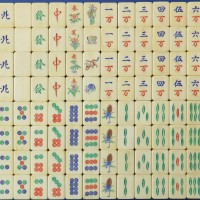
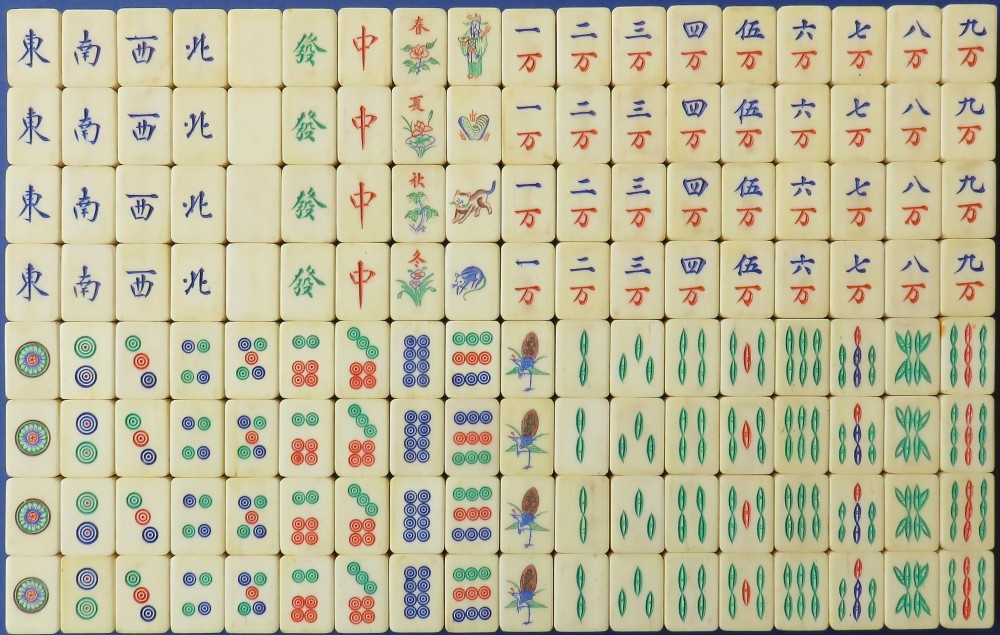
This is a small tiles set more commonly associated with the size of early documented sets such as the Glover set from 1875. The left quartet are the Seasons and are the usual sinograms for Spring, Summer, Autumn and Winter and accompanied with plants, a peony, lotus bloom leaf and bud, ?, narcissus. The right quartet consist of two sets of pairings - the nobleman with a silver ingot and a cat with a rat. So, the nobleman attains wealth? and the cat catches the rat.
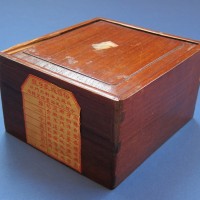
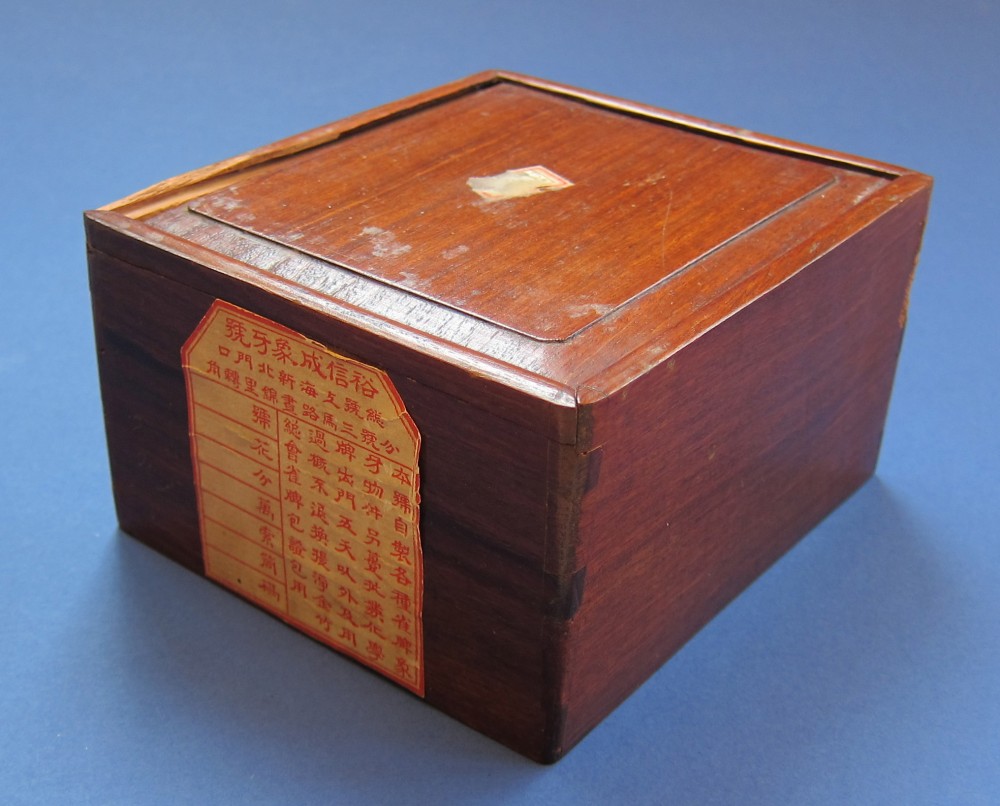
This box is probably the earliest style of box we know of, that accompanied tile sets. The earliest incarnation is with the Wilkinson set of 1889 and the with the Laufer set of 1901. It has a slide top lid and makers label on the side.
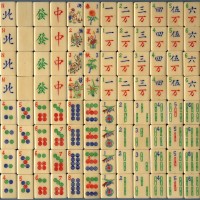
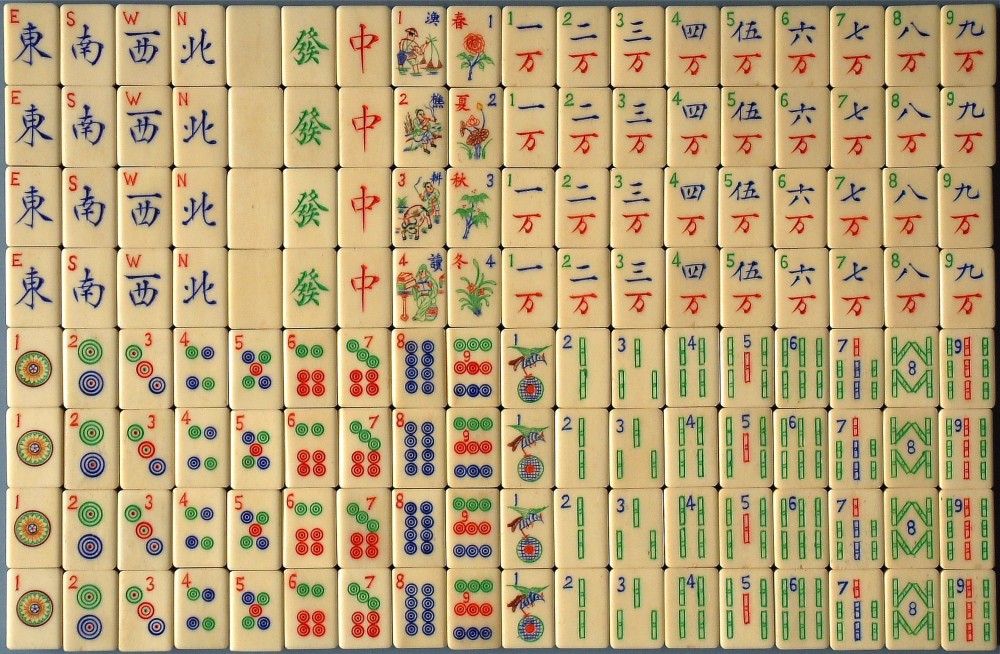
Another tile set with small tiles, in excellent condition. Simple engravings for the suits with the use of yellow on the number one circle. The Flowers and Seasons bear finely executed engravings. The left quartet reads; yu 'fisherman'; qiao 'woodcutter'; geng 'farmer' and du 'scholar'. The right quartet reads; chun, 'Spring'; xia, 'Summer'; qiu, 'Autumn' and dong, 'Winter'. The plants are the peony, 'mu-dan' which here symbolises 'riches and reputation'; the lotus bloom, bud and leaf symbolising 'complete union'; the plum tree? may symbolise 'many children' (through having many kernels); narcissus symbolising a married couple = combined these may say "may you have riches with concord in marriage with many children". The number one SoC/'Bamboo' has a bird flying over a globe with a red patch in it. This may show the Earth with China (the Middle Kingdom) at its centre coloured in red.
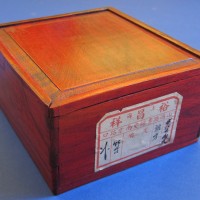
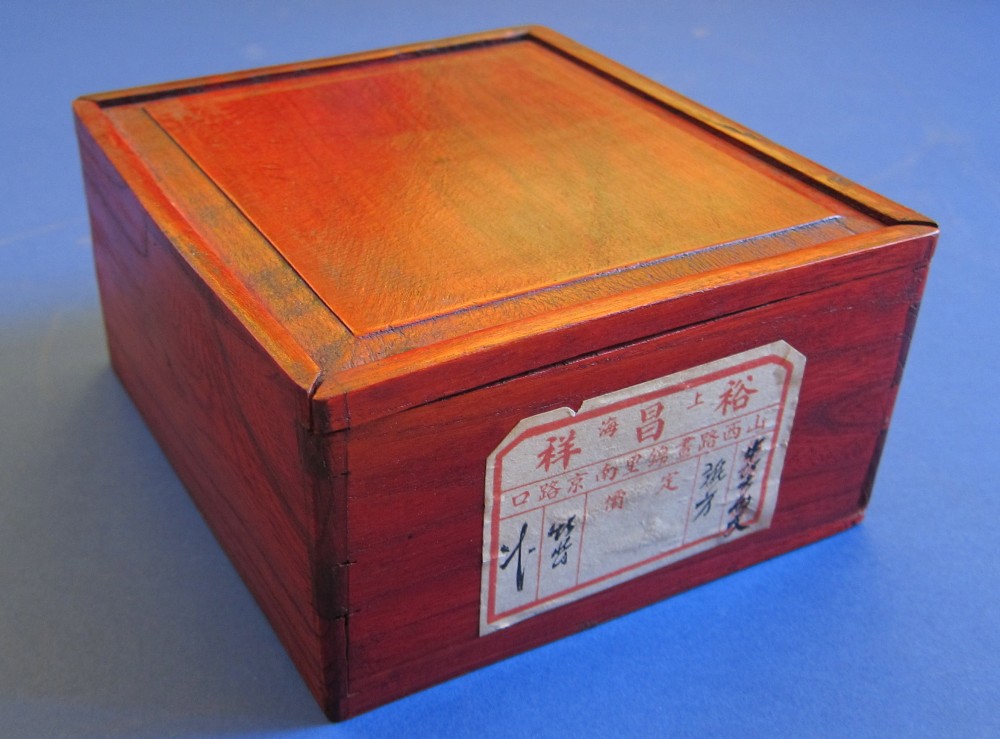
Small, red-stained, cubic shaped box, complete with original wrapping paper and makers card inside. Makers label on the side. Slide-top lid.
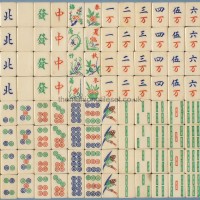
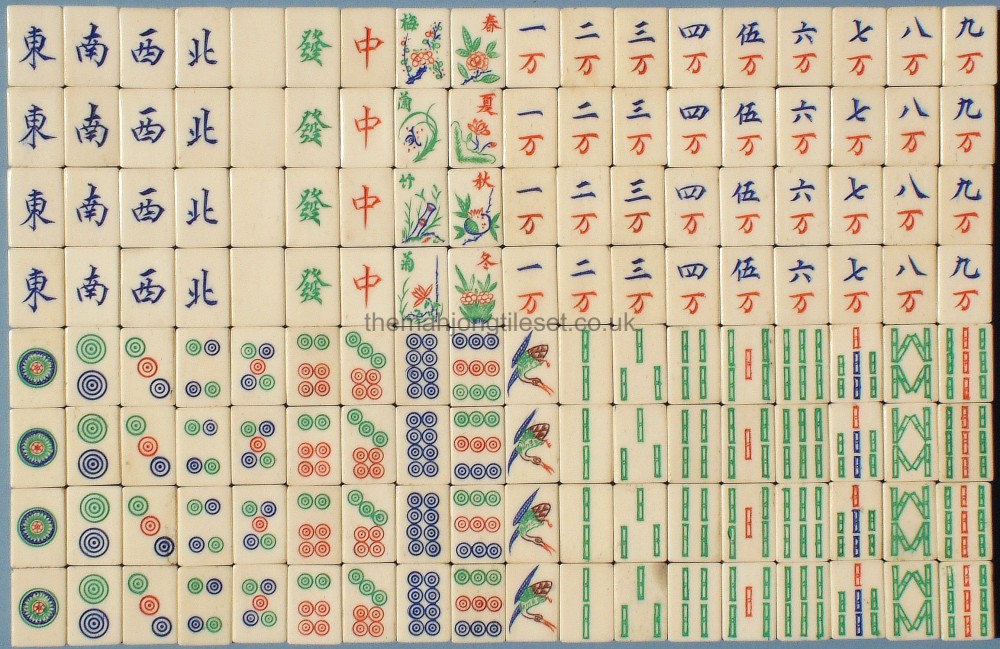
Another basic tile set. Simplified engravings for the suits. A Crane on the number one 'Bamboo'. Again, note the central right sub sinogram 'shu' (spear) in the green 'Dragon' sinogram rather than the earlier sub sinogram 'shi', meaning arrow. Flowers are li (plum), lan (orchid), zhu (bamboo) and ju (chrysanthemum). The Seasons are chin (Spring), via (Summer), qiu (Autumn) and dong (Winter). The plants are mu-dan (peony), lian (lotus), shi-liu (pomegranate) and shui-xian (narcissus). The peony may symbolise 'riches', the lotus blossom, bud and leaf symbolise 'complete union', the pomegranate symbolises 'many children' and narcissus 'married couple'. Hence the blessing is "may you have a complete union as a married couple with many children and riches".
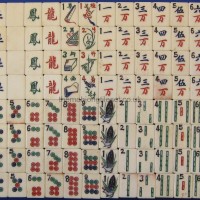
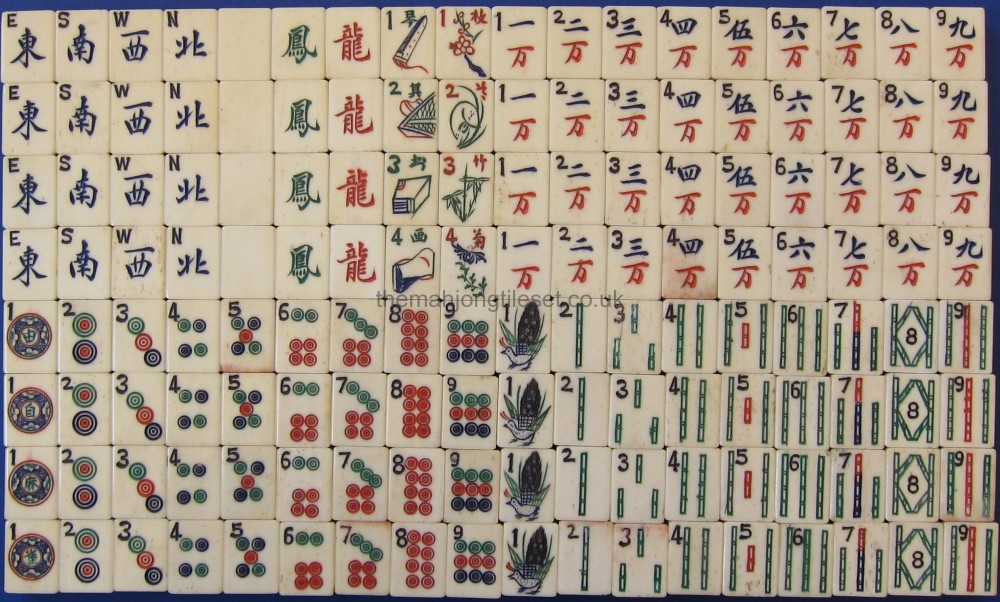
This set was produced by the Mah Jongg Company of China, Shanghai, for the Mah Jongg Sales Company of America, 112 Market Street, San Francisco. It is housed in a black-stained mahogany box with a slide top lid. In their 1922 catalogue the black and rosewood coloured boxes are listed under 'style 103'. However, in their 1923 catalogue only the rosewood coloured box is listed. It appears the black coloured box set may be from 1922. Simple designs are used for the three suits. Note the use of the the red sinogram, lóng, 'Dragon' and the green sinogram, fèng, 'Phoenix' for two of the three Honours tiles. The number one Cash/'Circles' tiles each have a sinogram at its centre. From the top; zì + yóu = zìyóu = 'free' and má qi ǎo = má qiǎo = Mah Jongg = "free Mah Jongg". The Seasons/Flowers left quartet read; qín 'lute', qí 'chess', shū 'books' and huà 'painting' - the four arts of the Scholar. The right quartet read; meí 'plum', lán 'orchid', zhú 'bamboo' and jú 'chrysanthemum' - the four noble plants.
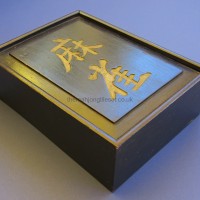
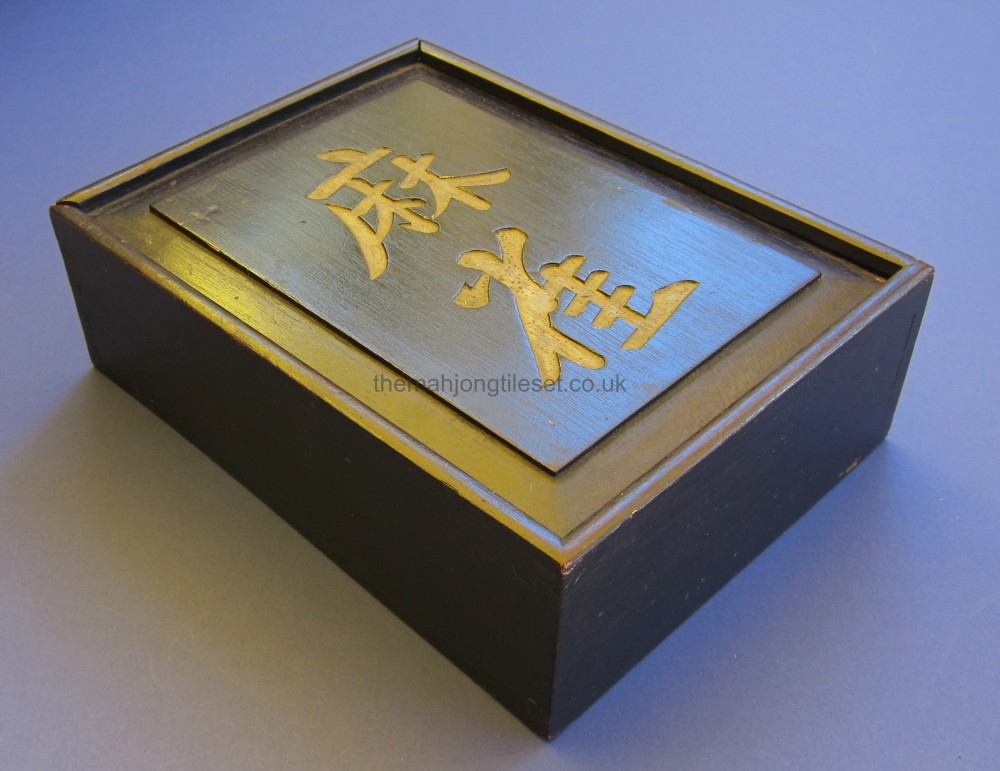
Black-stained mahogany box 'Style 103', with a sllde top and two gold painted ma qiao/'Mah jongg' sinograms. Three compartments inside.
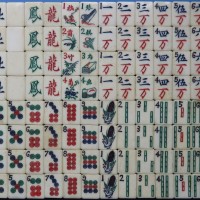
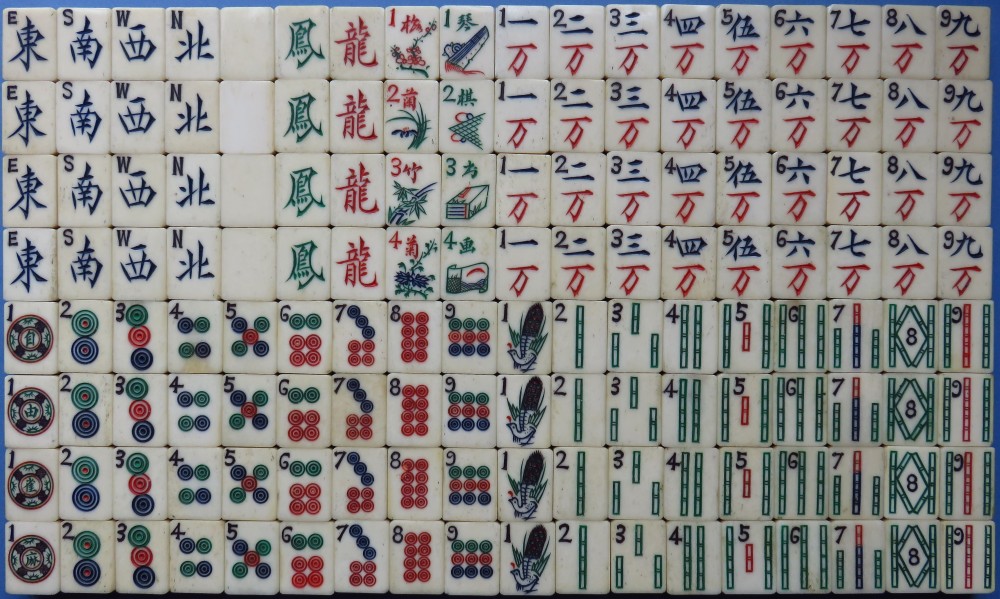
Another 'Style 103' set produced by the Mah Jongg Company of China for its sales outlet the Mah Jongg Sales Company of America, 112 Market Street, San Francisco.
As with the previous set, it is housed in a black-stained mahogany box with a slide top lid.
Simple designs are used for the three suits. Once again, note the use of the the red sinogram, lóng, 'Dragon' and the green sinogram, fèng, 'Phoenix' for two of the three Honours tiles. Also note the use of red for the #8 Cash/'Circles' tiles.
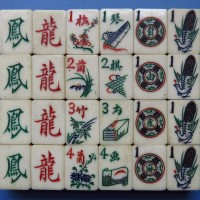
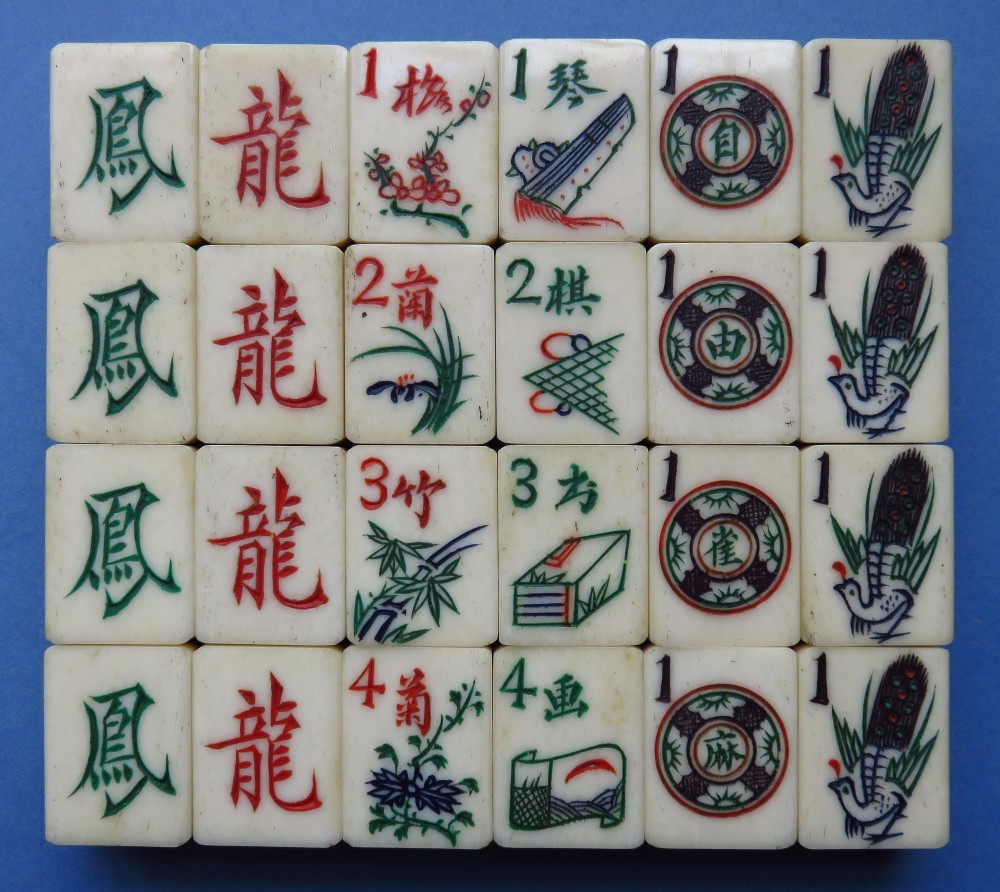
Close-up of the #1 'Circle' and 'Bamboo' (a bird) as well as two of the three Honours tiles or 'Dragons' and the two Flowers and Seasons quartets.
From the left:
Note the use of the the green sinogram, fèng, 'Phoenix' and the red sinogram, lóng, 'Dragon' for two of the three Honours/'Dragon' tiles.
Next, the Seasons/Flowers left quartet read; méi 'plum', lán 'orchid', zhú 'bamboo' and jú 'chrysanthemum' - the four noble plants. The right quartet read; qín 'lute', qí 'chess', shū 'books' and huà 'painting' - the four arts of the Scholar.
The number one Cash/'Circles' tiles each have a sinogram at their centre. From the top; zì + yóu = zìyóu = 'free' and má + qiǎo = má qiǎo = Mah Jongg, thus "Free Mah Jongg".
Finally is a bird - sometimes interpreted as a crouching Peacocks and sometimes a 'coin-carrying bird'.
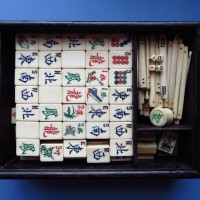
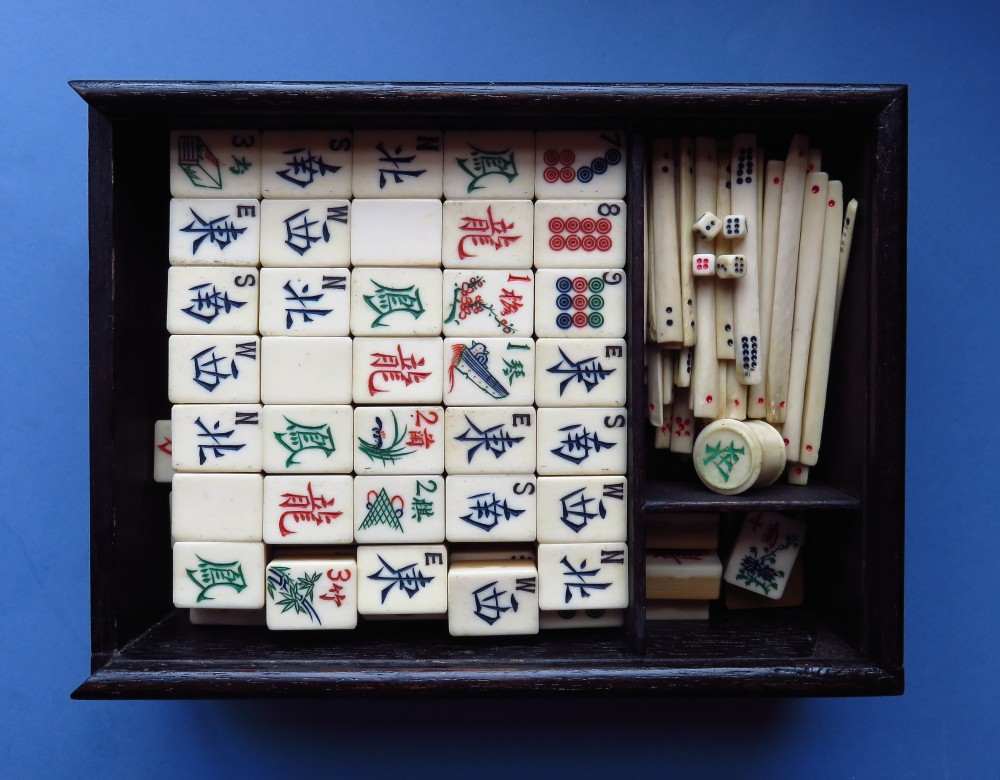
Identical box interior to Tile Set Box 23 above. Three interior compartments. Note the presence of accessories such as the scoring sticks, zhuāng bone pot for holding the Direction/Wind indicator discs, four bone disc plus spares tiles.
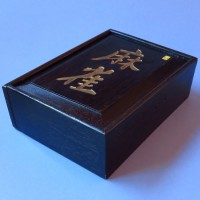
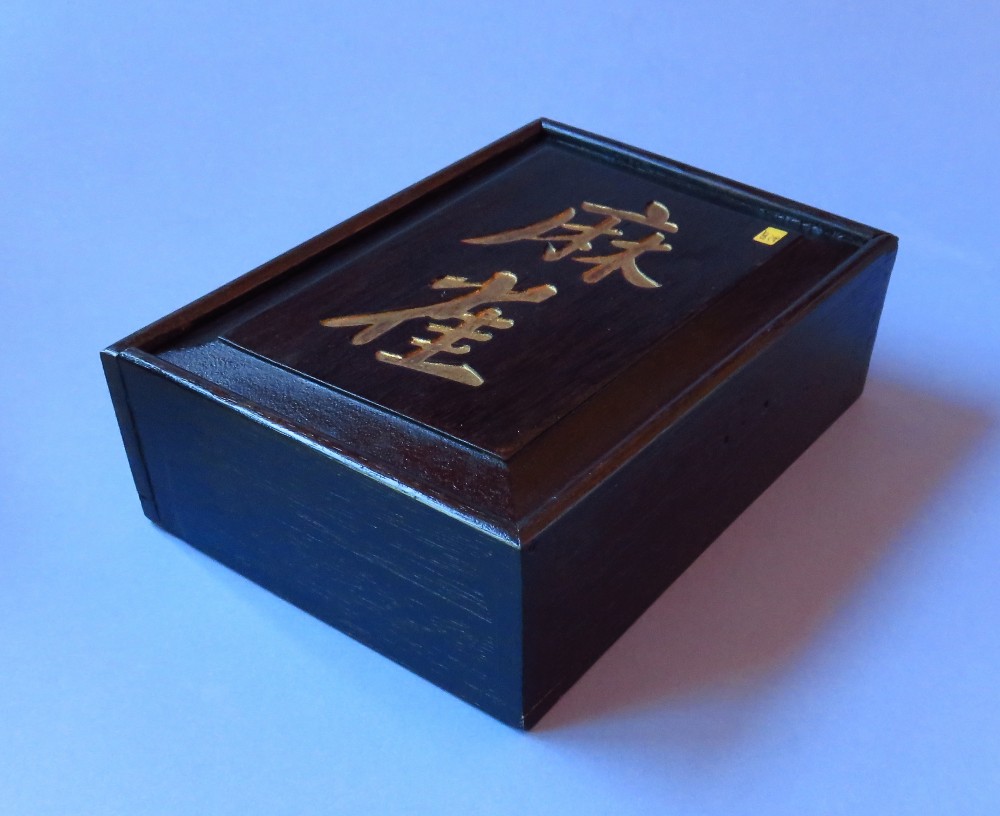
Identical to Box 23. Thus we have a black-stained mahogany box 'Style 103',with a sllde top and two gold painted ma qiao/'Mah jongg' sinograms. In their 1922 catalogue the black and rosewood coloured boxes are listed under 'style 103'. However, in their 1923 catalogue only the rosewood coloured box is listed. It appears the black coloured box set may be from 1922.
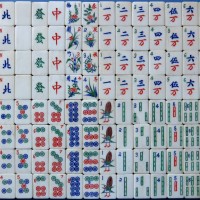
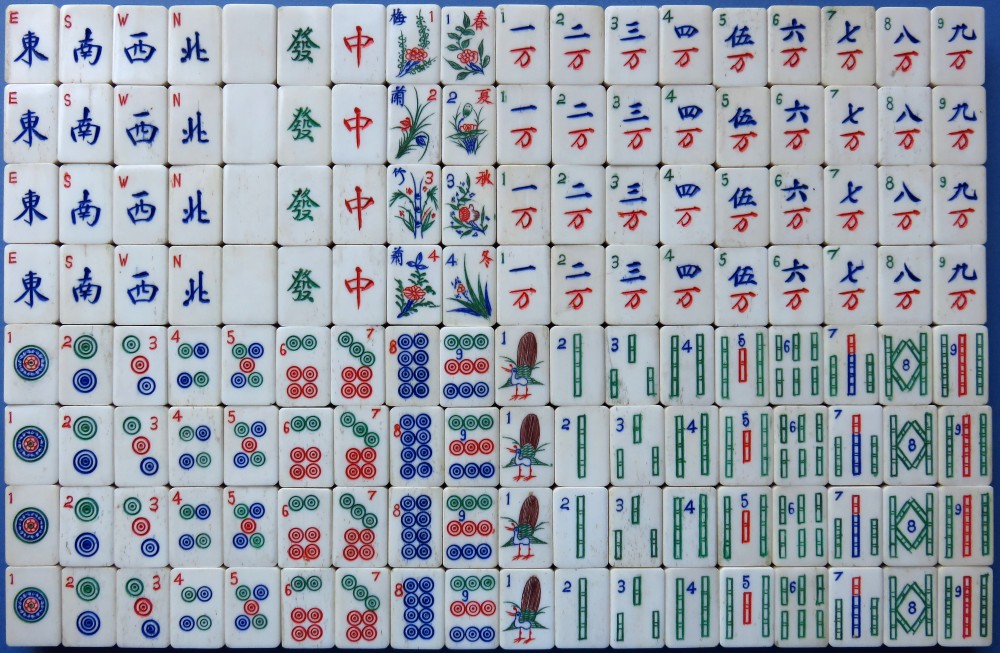
A basic Culin-patterned tile set. Thus we have the three suits, the Directions/Winds, the 'Dragons and the 2 quartets of bonus tiles usually called Flowers or separately as Flowers and Seasons.
In this case the left column sinograms are Plum, Orchid, Bamboo and Chrysanthemum = the Four Noble Plants, and it is these that are engraved on each tile, respectively.
The right column sinograms are Spring, Summer, Autumn and Winter. Similar to tile set 30, we have on each tile, starting at the top, we have the peony which here symbolises 'riches and reputation'; the lotus bloom, bud and leaf symbolising 'complete union'; the pomegranate fruit seeds symbolising 'many children' (through having many seeds); narcissus symbolising a married couple = combined these may say "may you have riches with concord in marriage with many children".
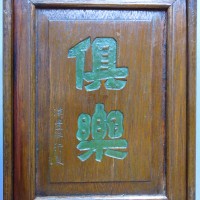
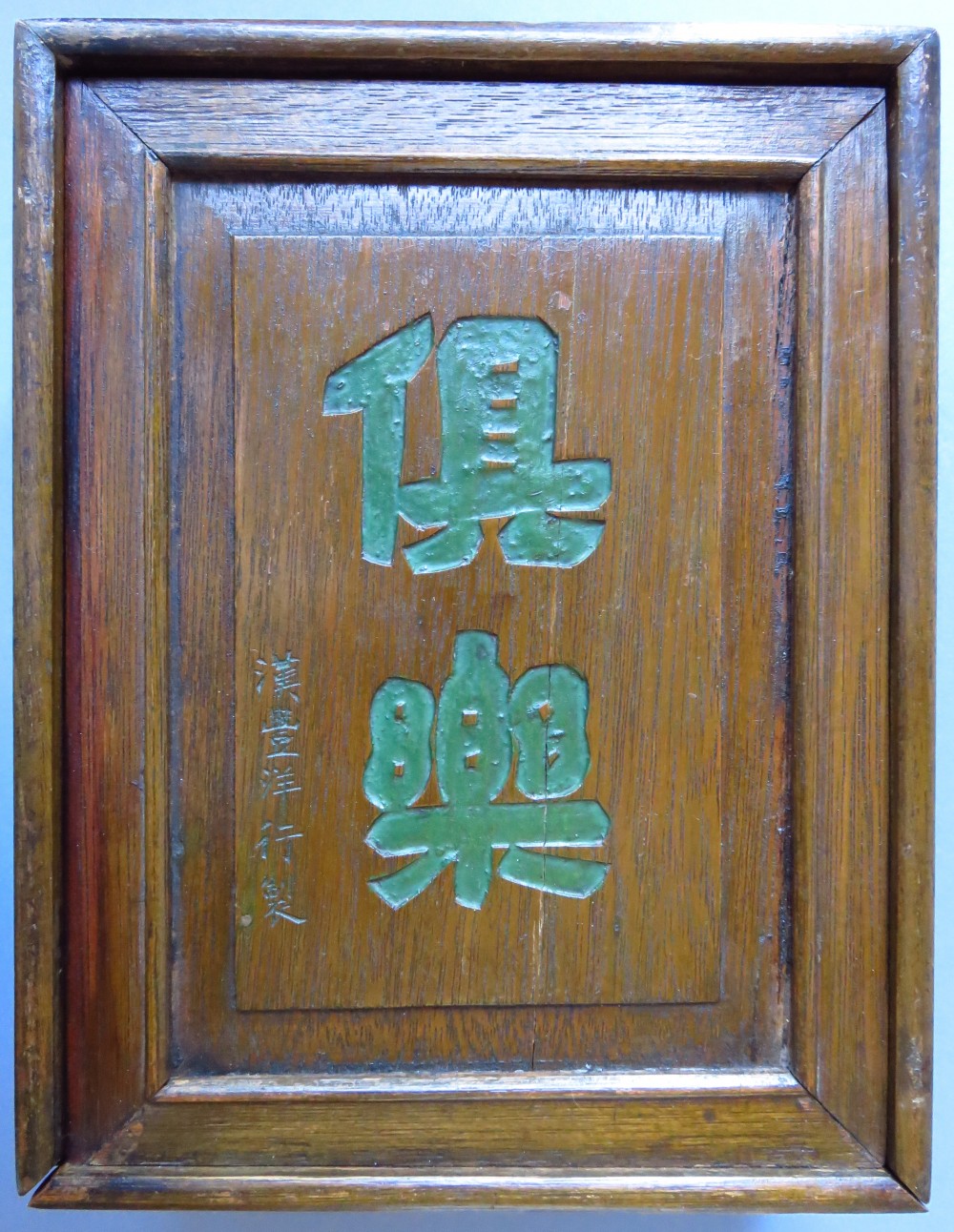
Top of the slide top lid showing the large green sinograms and a small row of sinograms down the left side.
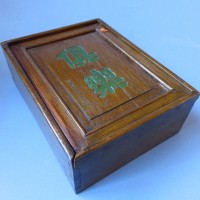
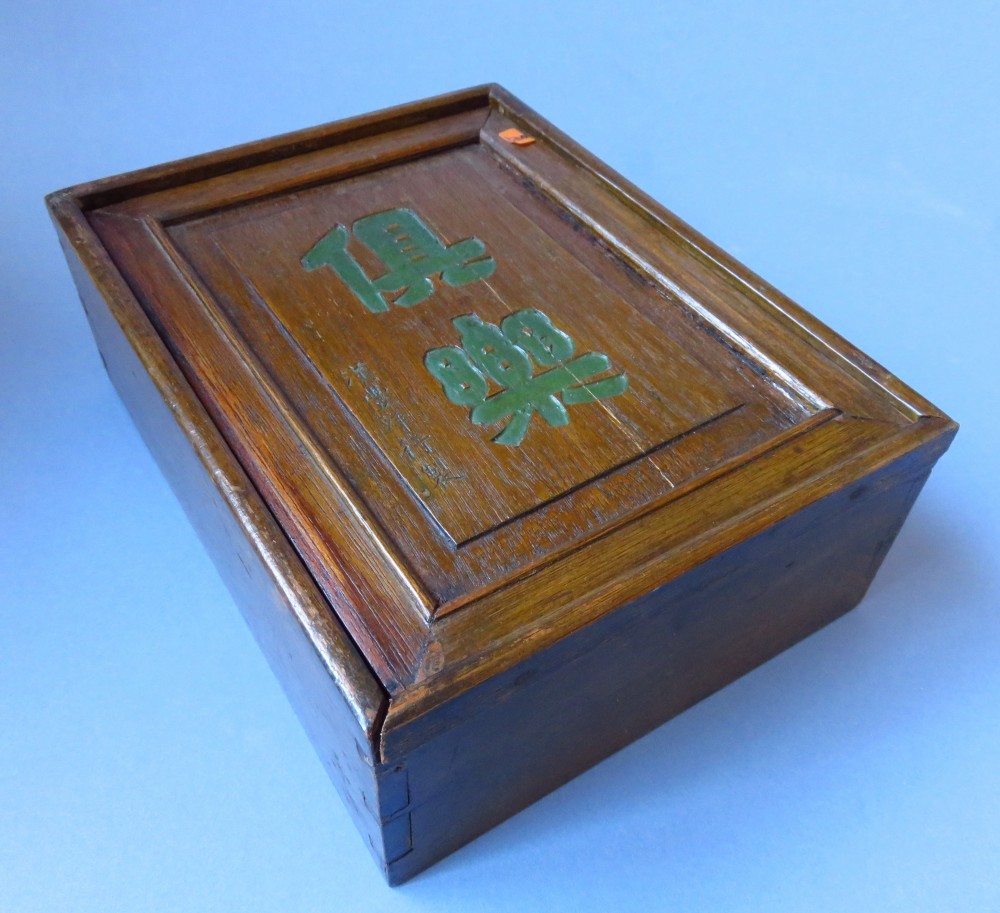
The box appears to be made from a mahogany-type wood. A few nail perforations are evident. The wood may therefore be from something like an old tea chest used for shipping tea.
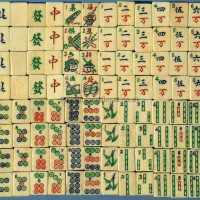
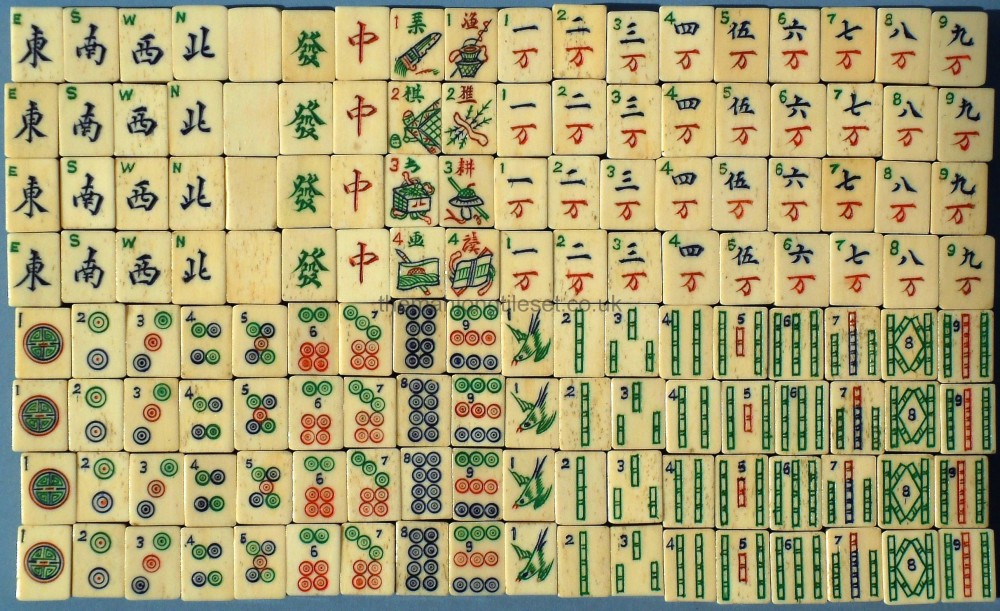
A set with small tiles. The number one Cash/'Circles' bear round symbols for shou, 'longevity' and the number one SoC/'Bamboo' has what is probably a darting sparrow, the earliest known incarnation of a bird as seen on the Culin tile set of 1910. The Flowers/Seasons left quartet read; qín 'lute'; qí 'chess'; shū 'books' and huà 'painting' = the Four Arts of the Scholar who is one of the Four Callings which are represented by the right quartet. Thus we have ; yú, (fishing) 'fisherman'; qiáo, (woodman) 'woodcutter'; gēng, (plough) 'farmer'; dú, (read) 'scholar'.
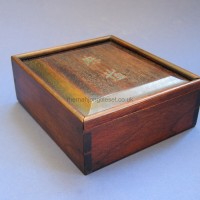
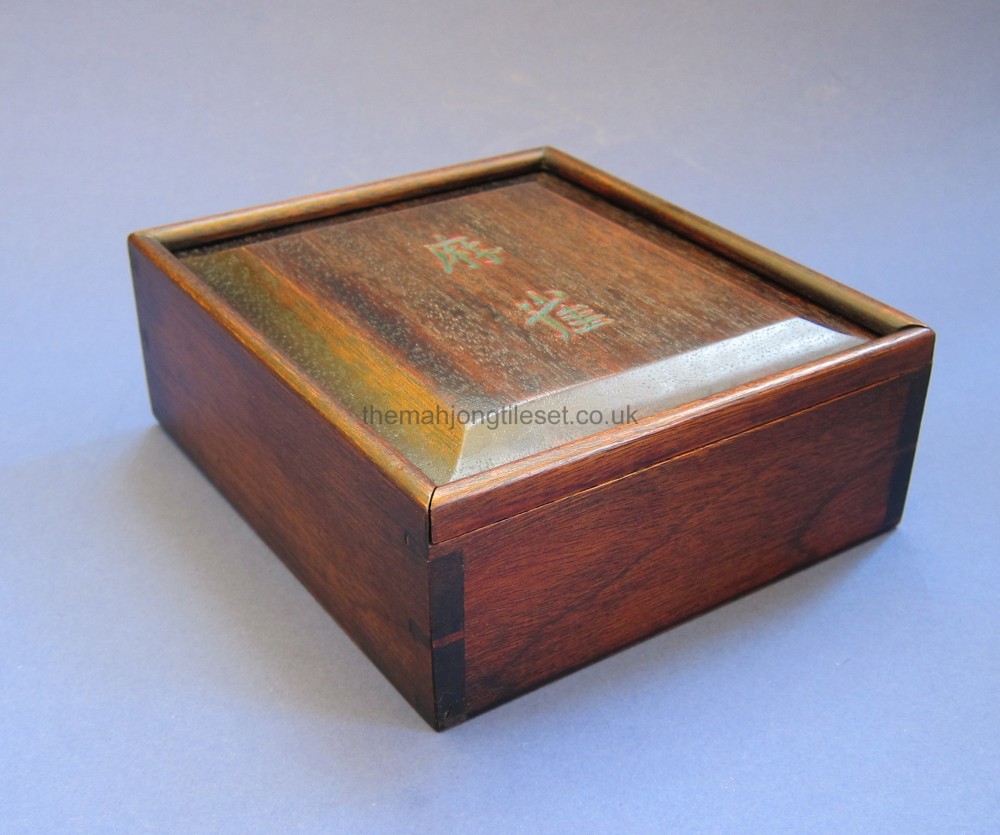
A small box custom made for this set. Slide top lid bearing the engraved characters 'ma qiao', Sparrow.
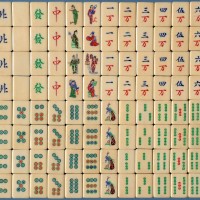
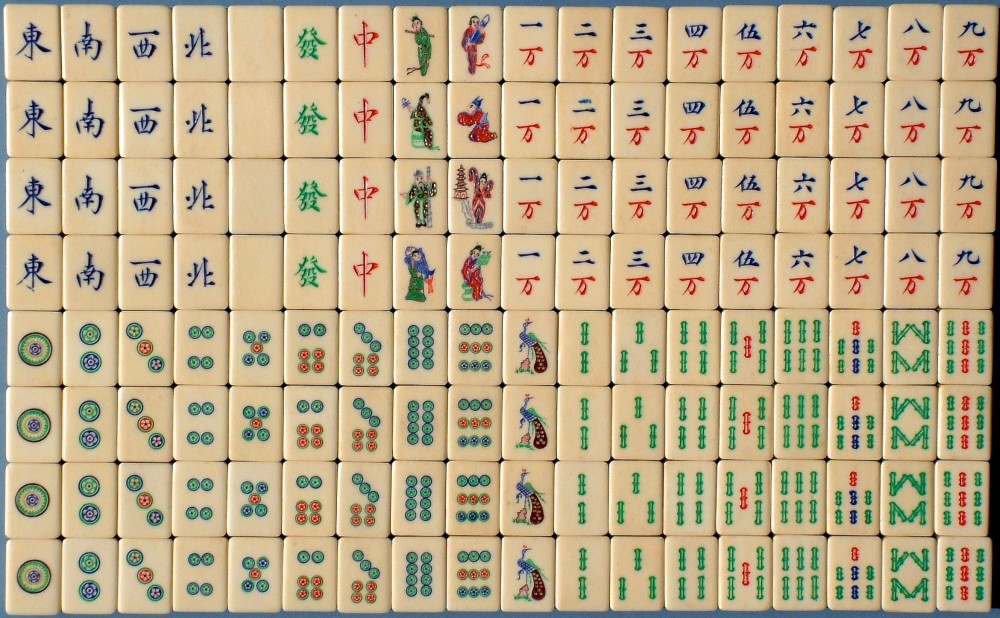
This set is the first example of a type of set housed in a flat, rectangular, wooden box with a slide-top lid, that was exported from Hong Kong, Japan and possibly Singapore as well as mainland China.
In this type of engraving pattern, there is usually a bird standing on one foot with its neck curved to the right on the one String of Cash/Bamboo tile. This set shows the Cash/'Circles and SoC/'Bamboo' suit having ornately engraved circles and rods whereas the Myriads (of Cash)/'Character' suit shows the simplified form of wan, 'myriads'. The 'Flowers and Seasons' tiles show groups of figures either clothed in green or red - the colours of life. These two quartets display detailed engraving and colouring. A fine example.
Due to scant documentation and first hand experience, this type of set (in a flat rectangular box) was tentatively assigned a date between 1950 and 1968. However, the bird on the number one Cash/'Circles' has been found on tiles from synthetic sets in attaché cases whose documentation suggests a 1930's date. Therefore it is entirely possible some of these sets date to that time. Note the absence of Arabic numerals and English letters.
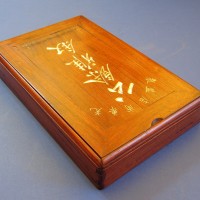
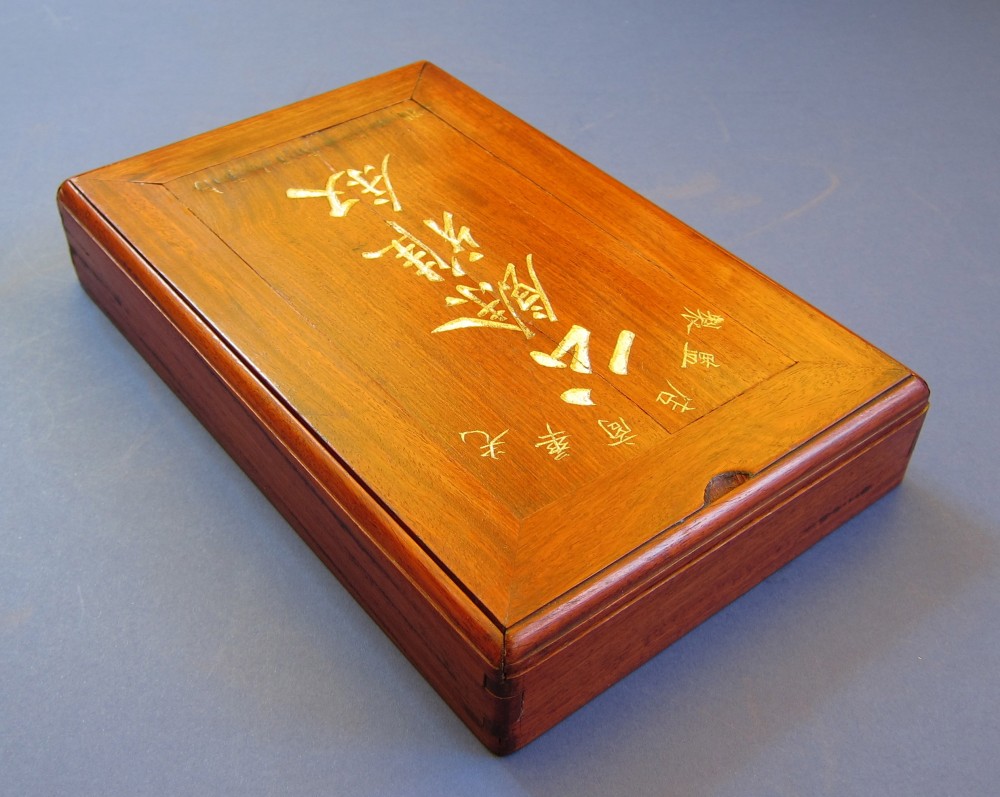
A flat, rectangular, box with a slide-top lid displaying four large sinograms painted in silver and an arch of smaller sinograms over the top. The arch sinograms read(R-L) guang hua shang dian jian zhi. Guang hua = light/glory/splendour and is used as a common name for businesses even today. Shang dian is 'trade and location' - simply 'store or shop'. jian 'supervise'; zhi 'production' and together mean 'production supervised by'. All together "Production supervised by Guanghua Shop". For the large sinograms; gung 'public/just'; yu 'surplus/profit'; ya 'elegant'; xu 'narrate' = "An Elegant Tale of Just Profit".
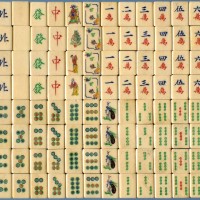
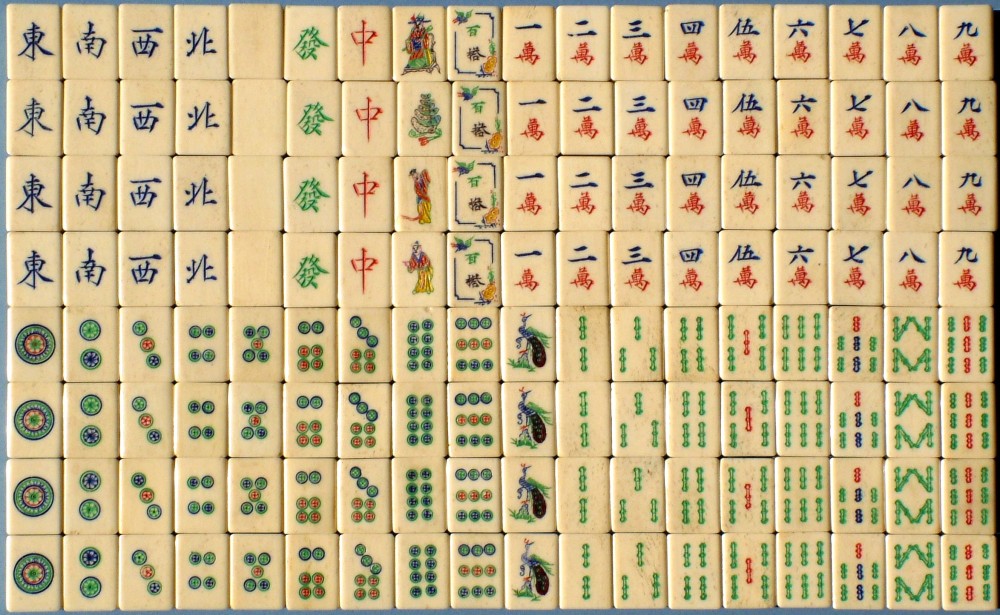
Thick-boned, small tiled set. Decoratively engraved suits with the traditional form of wan used for the myriads (of Cash)/'Character' suit. The use of yellow is uncommon. Absence of English letters and Arabic numerals. The left quartet of Flowers/Seasons appears to show the God of Wealth? with silver ingots. The other two figures are unknown at this point. The right quartet feature the sinograms 'bai da', one hundred joints/matchings = 'Joker' tiles.
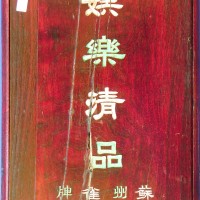
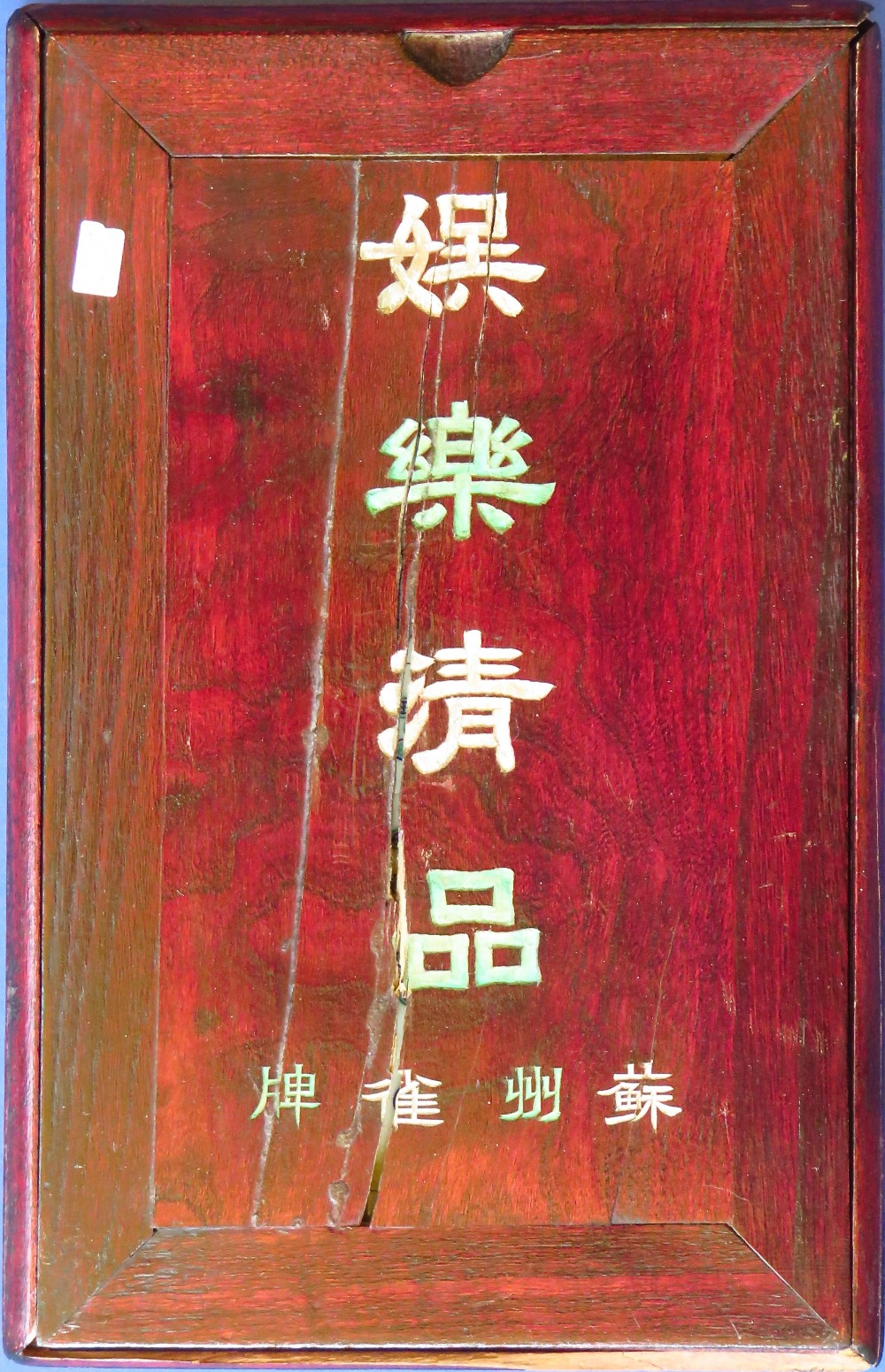
A richly stained wooden box with slide-top lid sporting four large engraved sinograms alternately coloured in white and green. Four similarly coloured smaller sinograms in a row underneath.
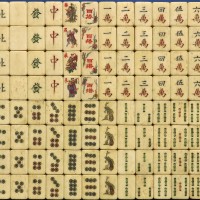
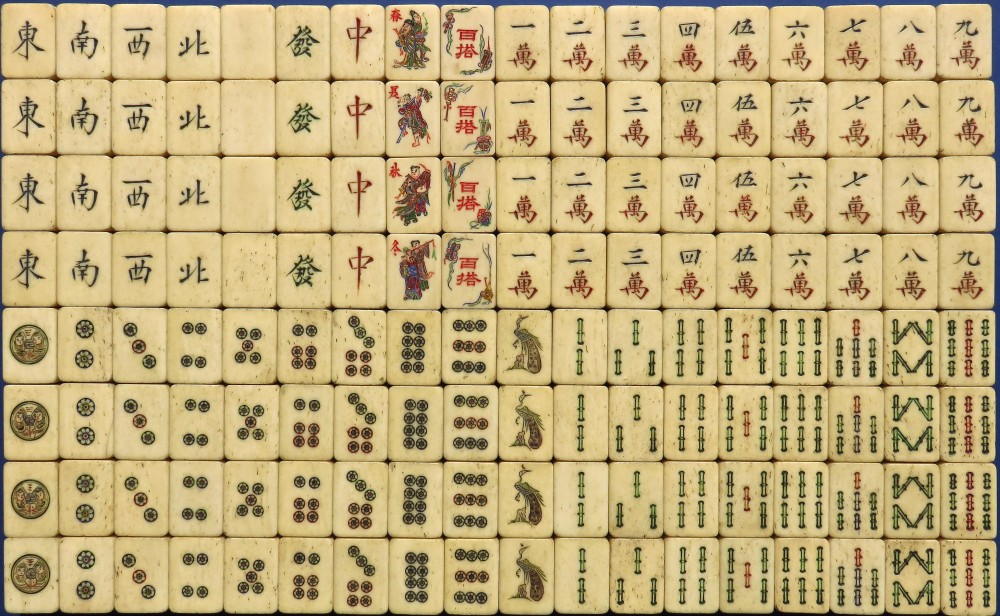
Tile set, sourced from Japan. Note the formality and symmetry of the engravings, symptomatic though not exclusive to Japanese engraved tiles.
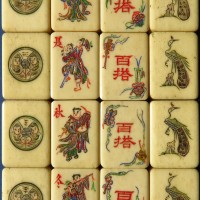
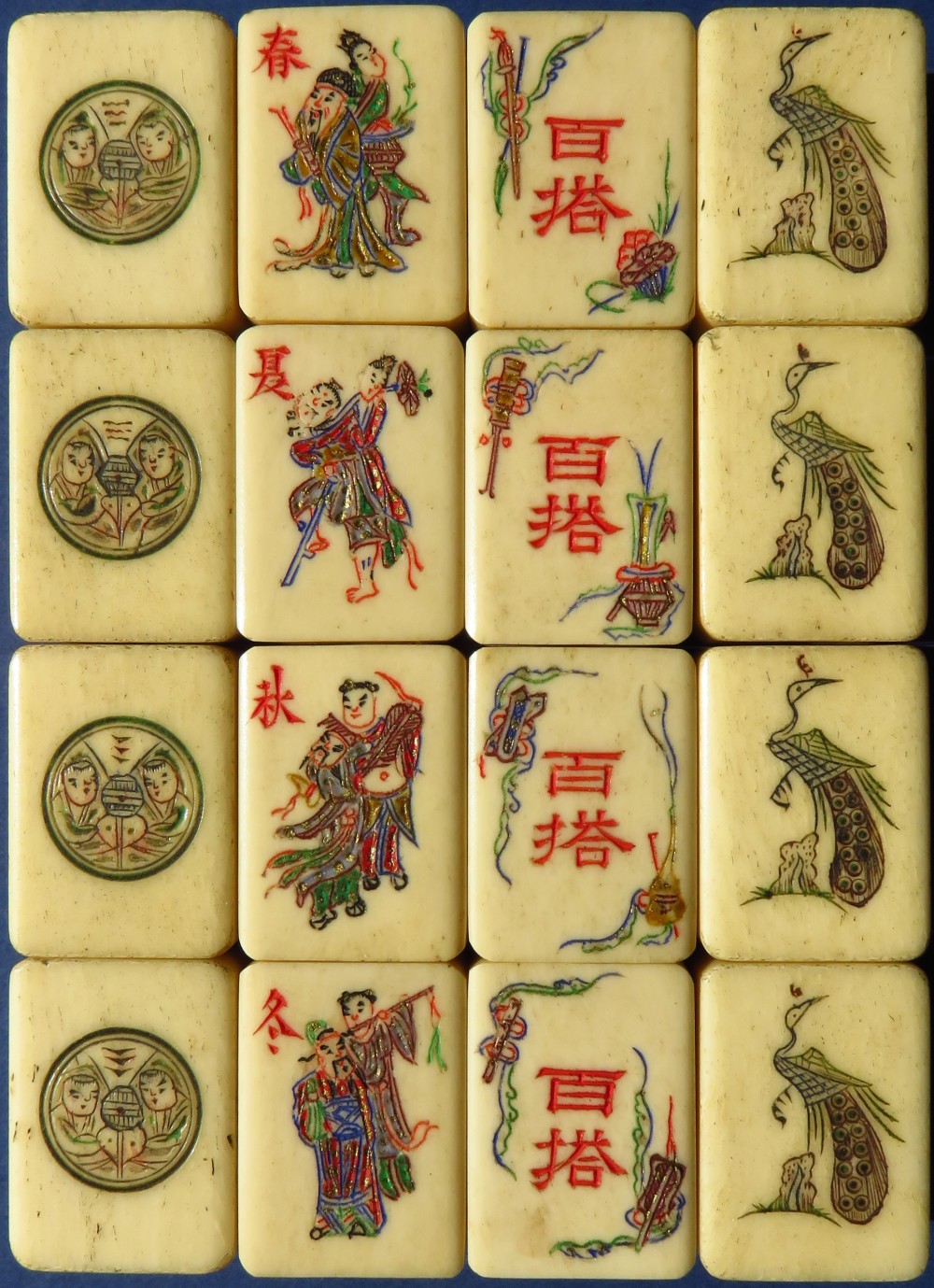
Close up of the one Circle and Bamboo tiles and the Seasons tiles plus the 'bai da' tiles = "one hundred uses" or "all purpose jokers". Exquisitely wrought engravings.
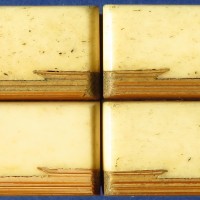
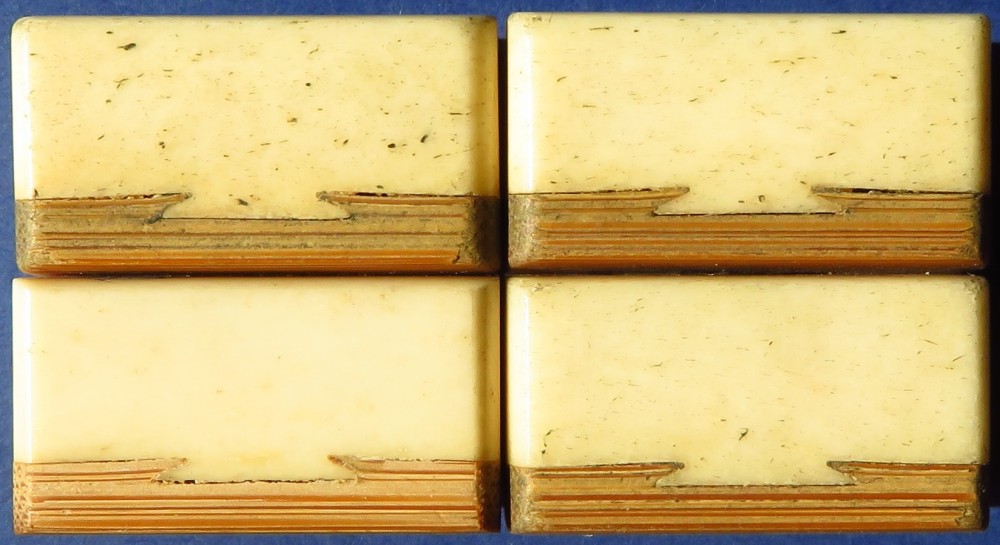
Note the thick bone. The bone to bamboo ratio is very high. This can be a usual though not exclusive trait found with Japanese tiles.
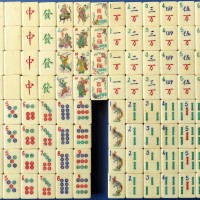
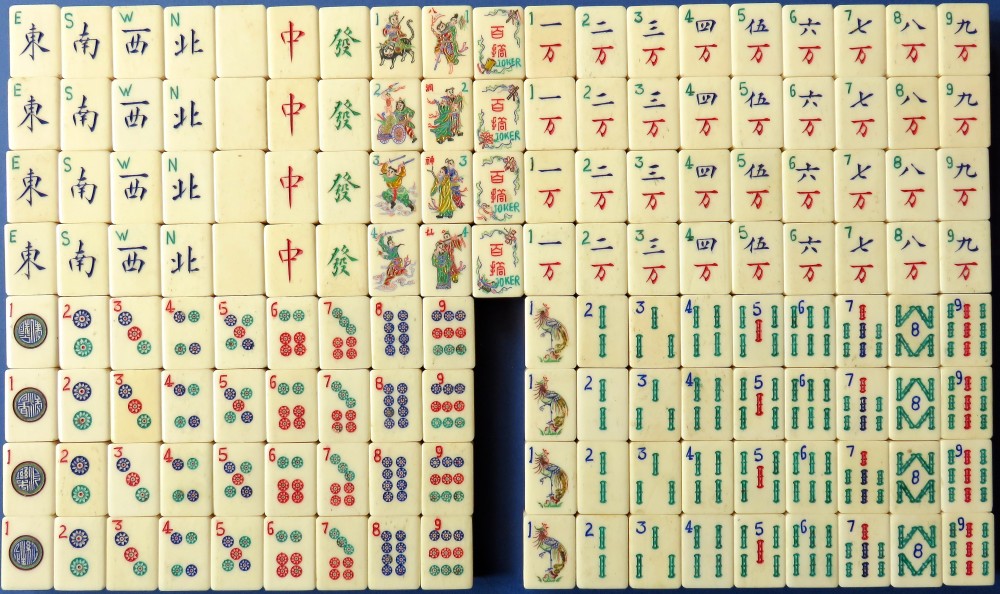
This set has either a 'Long-tailed Bird' or a Phoenix on the one 'Bamboo', sinograms in the one Circles and the sinograms bai da, 百 搭 in an unusual script = 100 joinings, in essence, all-purpose Jokers. As above, these are substitution tiles for any other tile.
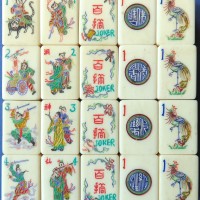
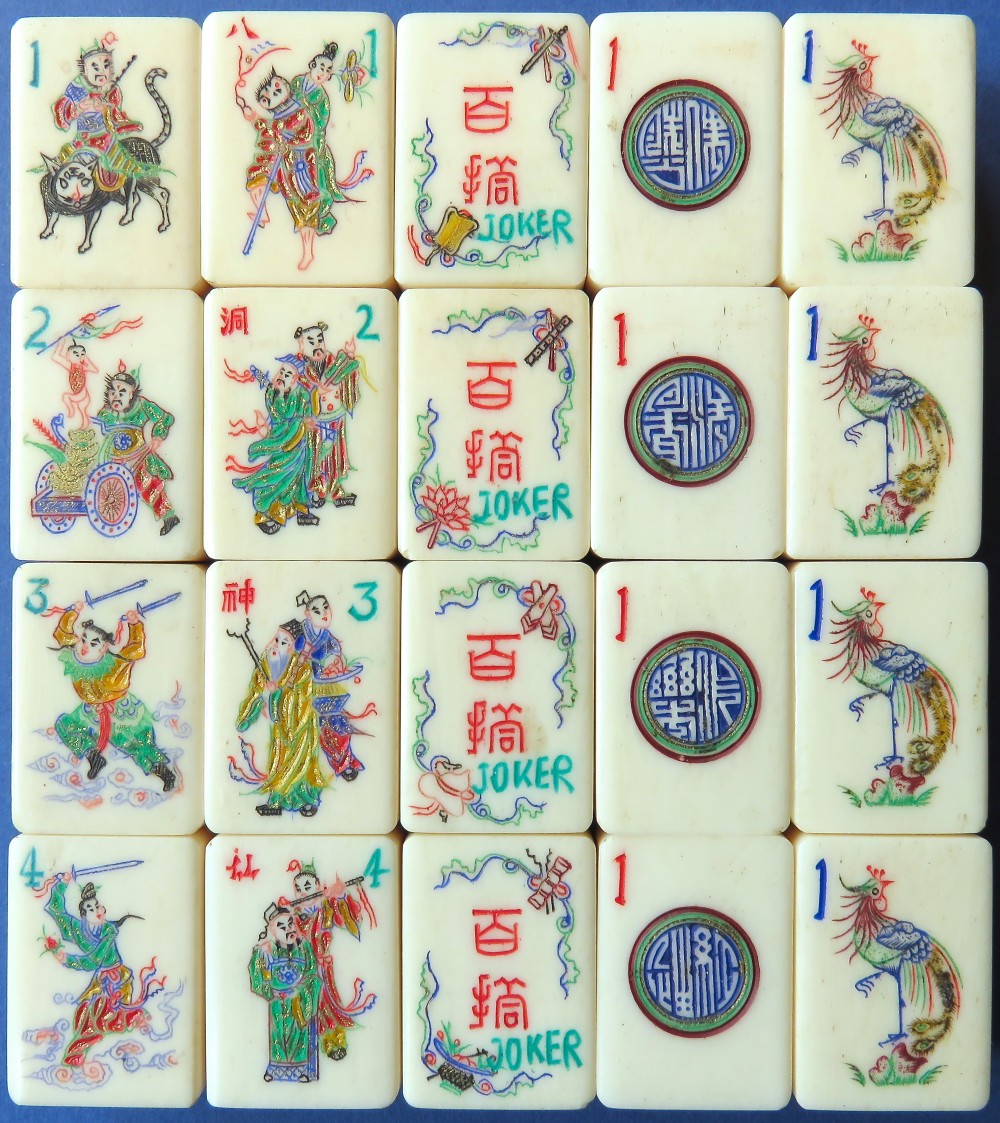
Close-up of the Flowers, The 'Jokers', the one Circles and the one Bamboos showing the fine delicate engraving and colour work.
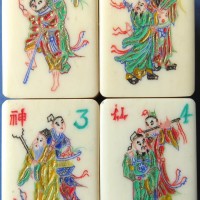
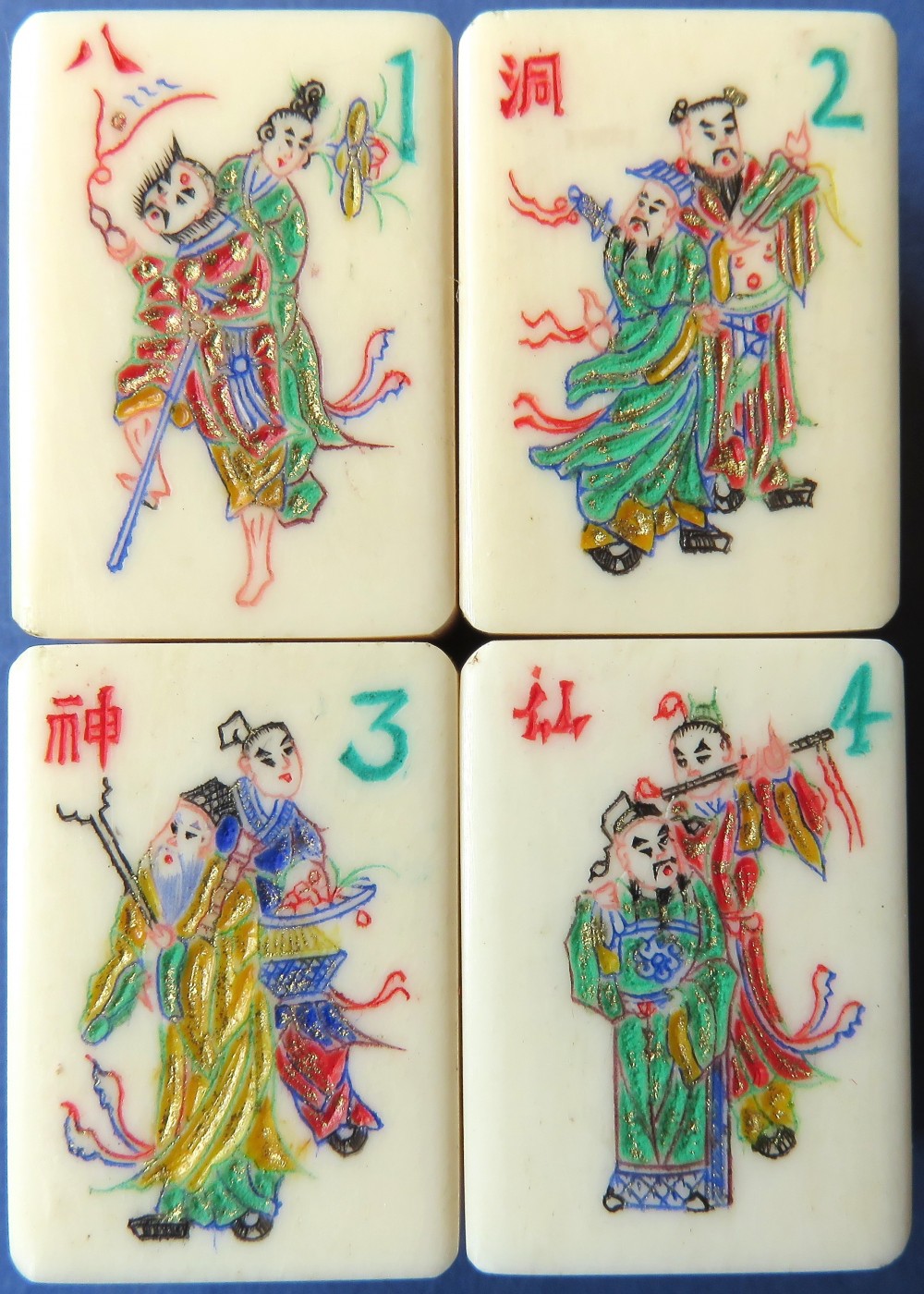
八洞神仙, in pinyin, Bā Dòng Shén Xian, which translates to the "Eight Cave Dwelling Immortals. The Eight Immortals were said by some, and in Daoist legend, to reside within caves. (Information provided by Ray Heaton).
On the number one tile are the pair Li Tieguai (front) with an Iron Crutch and a Pilgrims Gourd from which his 'soul' is leaving. Behind him is He Xian Gu with her emblem of the Lotus.
On the number two tile we have Lu Dongbin (front) with a Taoist Fly-brush and his emblem the Sword, slung across his back. Behind him is Zhongli Quan with his emblem a Fan.
On the number three tile are Zhang Guolao (front) with his emblem of a bamboo tube and two Two Rods to beat it. Behind him is Lan Caihe, wearing a blue gown and carrying their emblem, a basket of Flowers.
On the number four tile are Cao Guojiu (front) and in his hand is his emblem, a Pair of Castanets. Behind is Han Xiangzi with his emblem, the Flute.
According to A. C. Williams in 'Chinese Symbolism and Art Motives', the Eight Immortals "each represent a different conditioning life, i.e.., poverty, wealth, aristocracy, plebeianism, age, youth, masculinity, and femininity."
The engraving and the application of the colouring on these tiles is exceptionally fine.
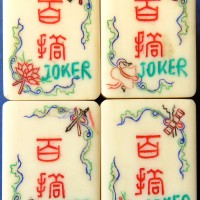
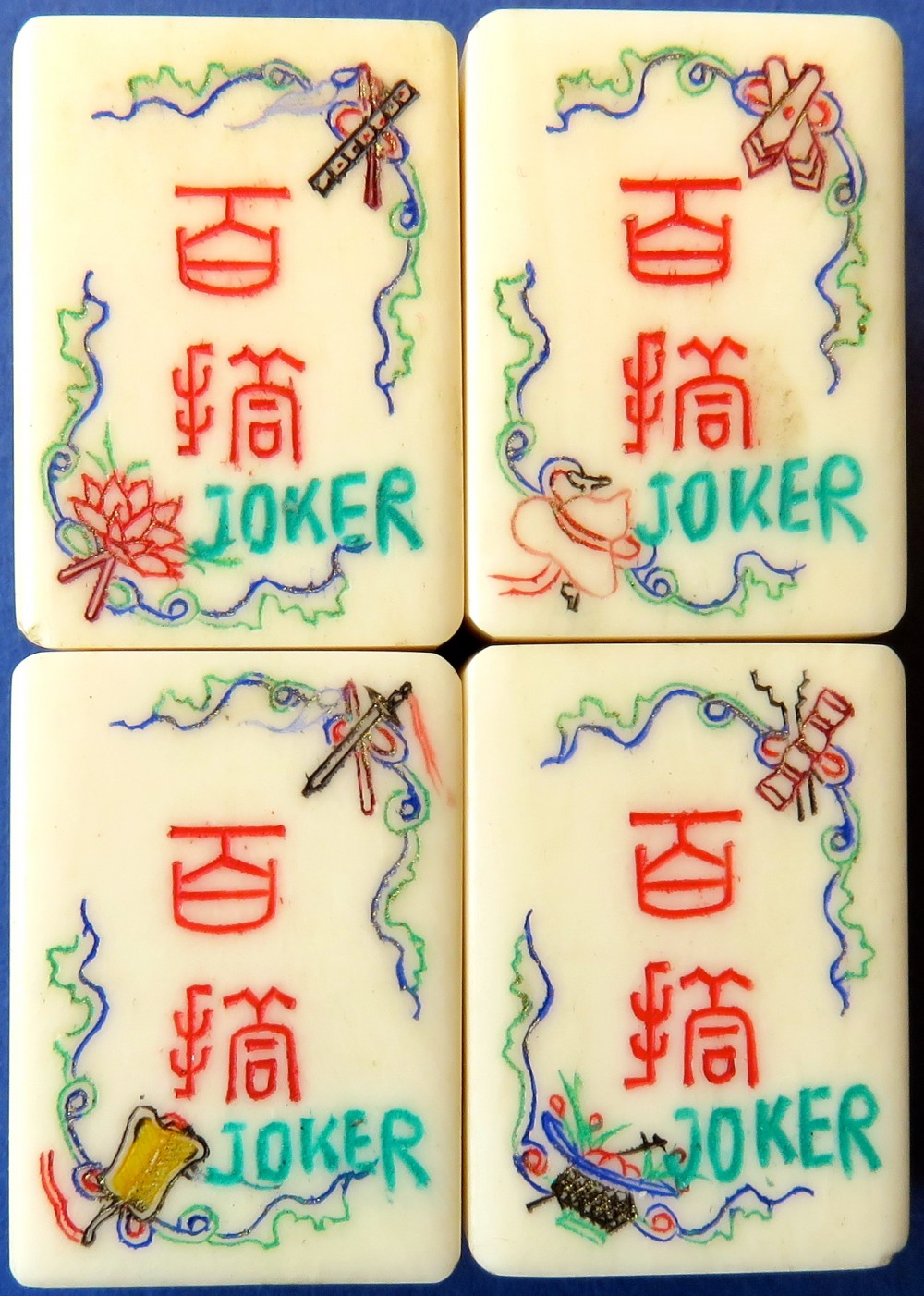
The four 'Jokers' or substitution tiles with the the sinograms bai da, 百 搭, '100 Uses', in red.
However, around these sinograms - from top right to bottom left on each tile - we have the "Covert or Hidden Eight Immortals" - emblems of the Eight Immortals. Starting from this arrangement and with the top left tile we have; the Flute of Han Xiangzi and then the Orchid of He Xian Gu.
The top right 'Joker' has the Castanets of Cao Guojiu and below that is the Gourd of Li Tieguai.
The bottom left 'Joker' has the Sword of Lu Dongbin and the Fan of Zhongli Quan.
The last 'Joker' has at the top the Bamboo Tube and Rods of the Immortal Zhang Guolao. At the bottom is a Basket of Flowers, the emblem of the Immortal Lan Caihe.
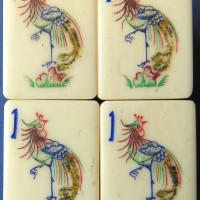
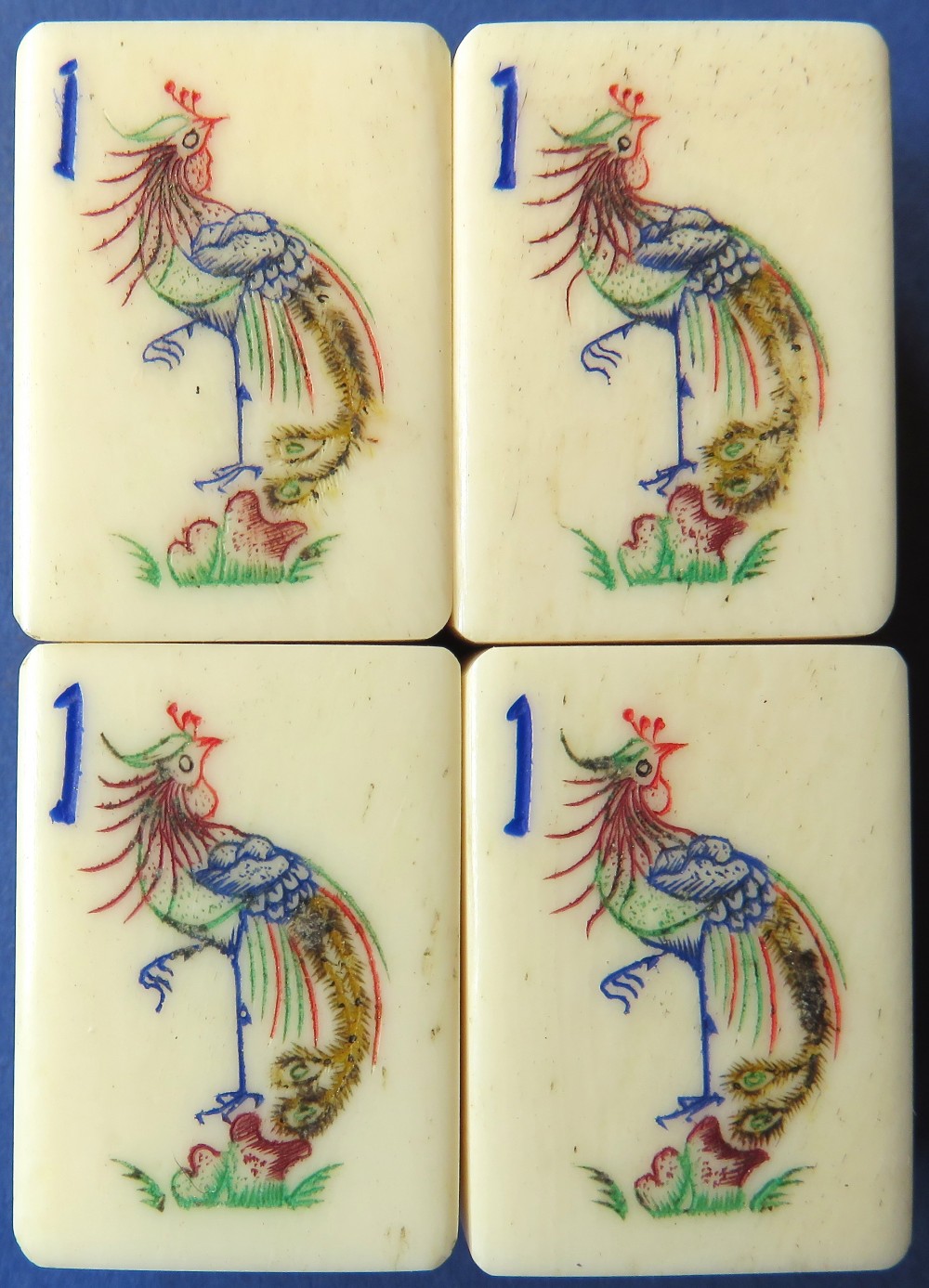
The four number one Bamboos showing what appears to be a fanciful representation for a Long-tailed bird. However, it also could be mistaken for a phoenix.
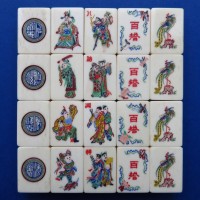
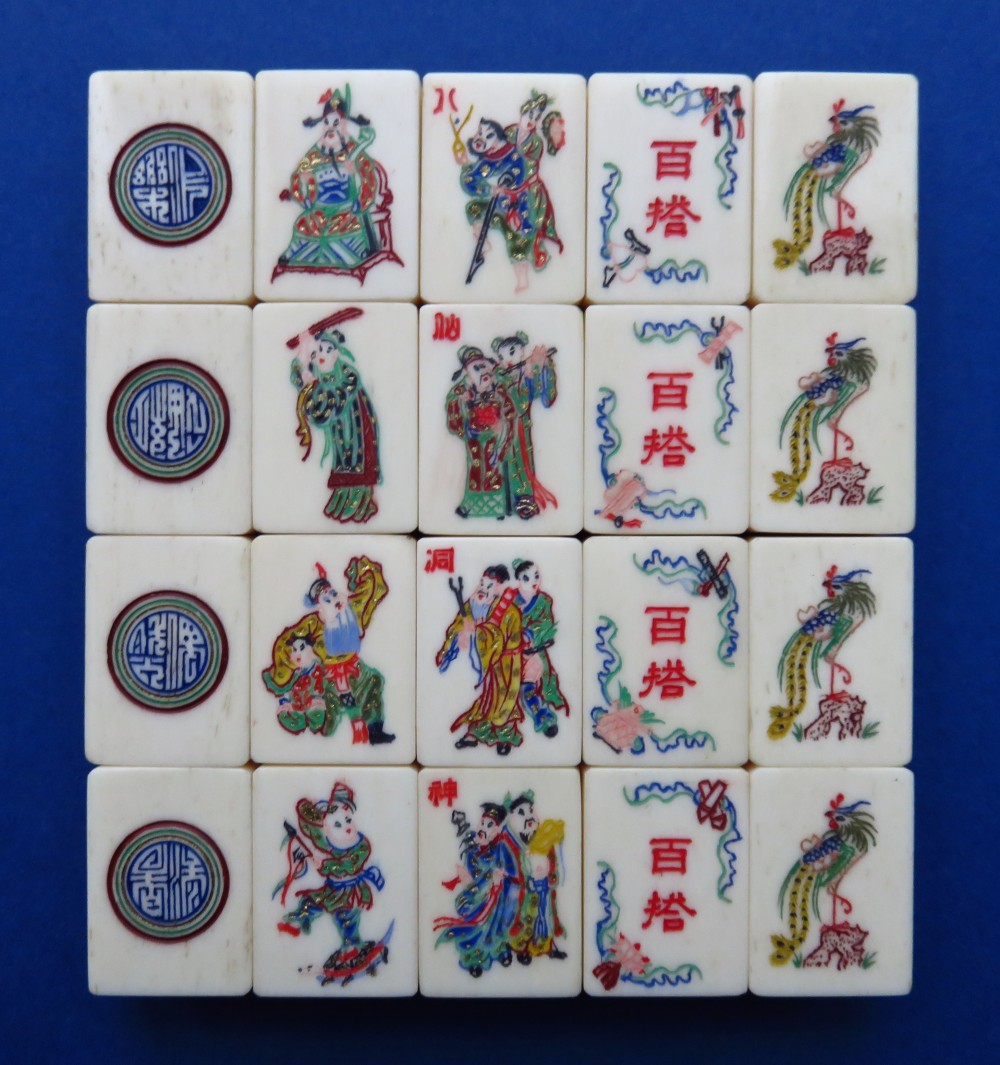
Close-up of the decorative 1 'Circle' and 1 'Bamboo' tiles including the eight Flowers tiles and the Bai Da (100 uses or Jokers tiles).
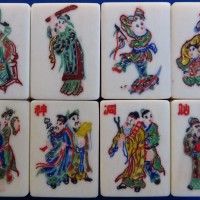
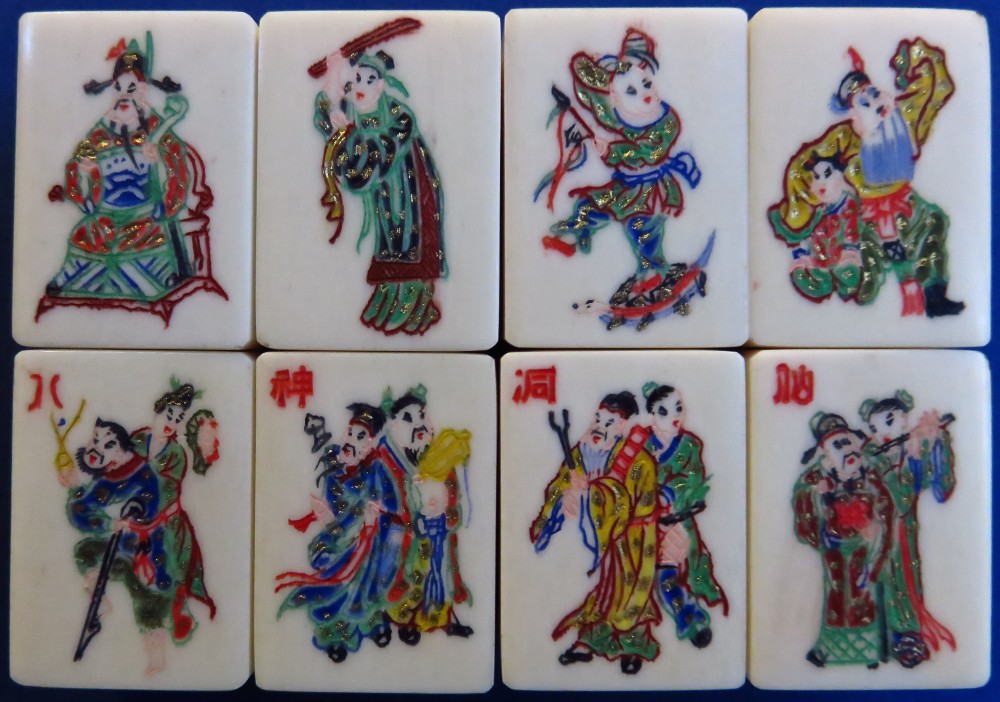
The lower row of Flowers are 八神洞仙, in pinyin, Bā Dòng Shén Xian , which translates to the "Eight Cave Dwelling Immortals". The Eight Immortals were said by some, and in Daoist legend, to reside within caves. (8 Immortals information provided by Ray Heaton).
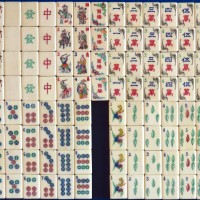
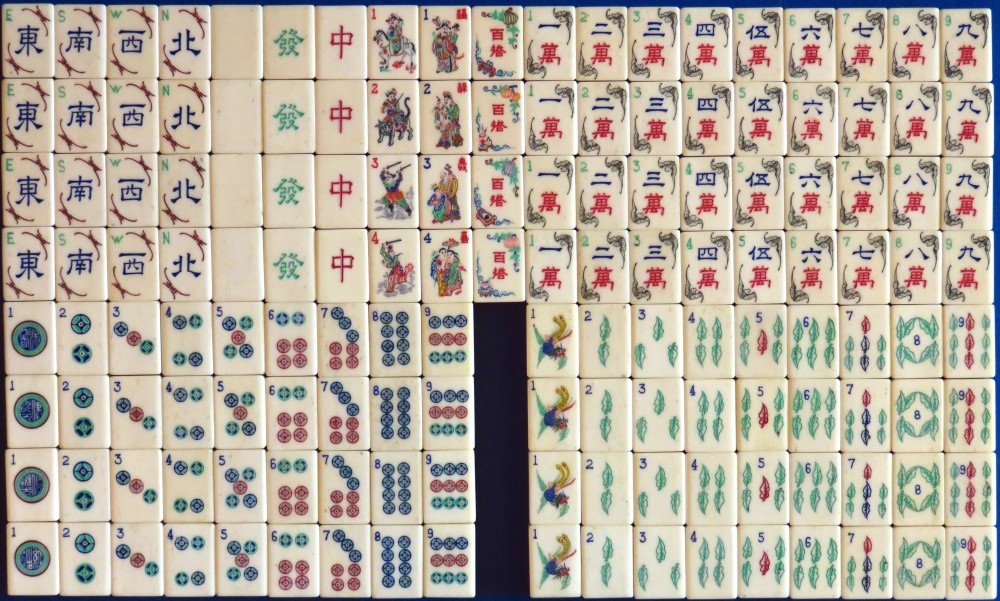
This is a rather uncommon example of a tile set that is nearly fully decorated, but presented in a flat, slide-top, rectangular box.
The Directions tiles are decorated with pairs of whisker-like symbols for shou 'longevity'.
The Myriads (of Cash)/'Character' suit has pairs of bats, the symbols for 'good fortune'.
The one SoC/'Bamboo' is decorated with what appears to be a flying Ribbon-tailed bird with a leaf in its beak while the rest of the suit shows just the leaves. Another name for this bird is the "Longevity-tailed bird". It is the symbol for longevity because the ribbons shou, 綬, are a pun for shou, 壽, 'longevity'. This emblem can be confused with the Phoenix, but that bird is generally depicted having many tails.
The four number one Cash or 'Circles' tiles are each decorated with a stylised sinogram while the rest of the suit is decorated with what may be colour patterns reflecting Chinese coins.
The left quartet of Flowers/Seasons is decorated with human figures. The sinograms have not been translated at this point.
The right quartet is similarly decorated with human figures.
The third quartet on the far right have the sinograms 'bai da' on each of them. The top, bai sinogram, means '100' and da means, in this context, 'to join' or 'to match'. Thus we have bai da, 百 搭 = 100 joinings/matchings. This indicates these four tiles are substitution tiles that can be used to substitute for any other tile. In other words, they are 'Jokers'. 'Jokers' are found in old Chinese money-suited card packs as well as in the two earliest tile sets we have documented - the Glover sets (see Mahjong(g) Before Mahjong(g) Part 1, under 'Tile set History')
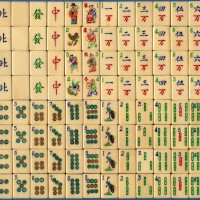
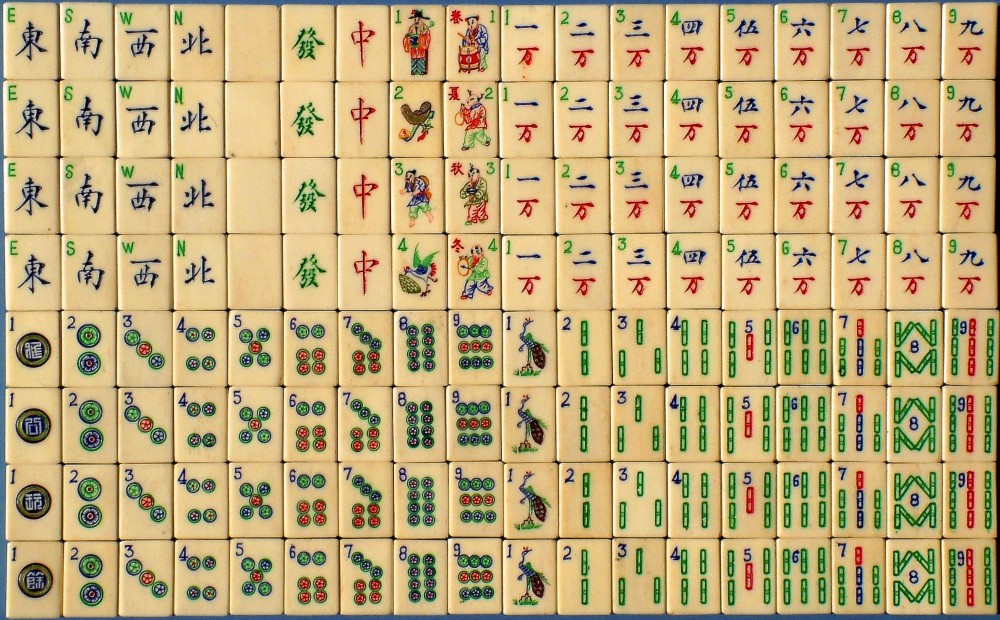
Small tiles. This set displays only the Cash/'Circles' having a ornate engraving pattern with flowers in the circles. The other two suits show the simplified versions (not ornate) of their respective suit patterns.
However, the presence of Chinese luck letters on the Circle 1 tiles plus the presence of the snipe and the clam in the Flowers tiles would indicate that this set might have been produced in Suzhou.
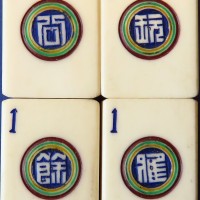
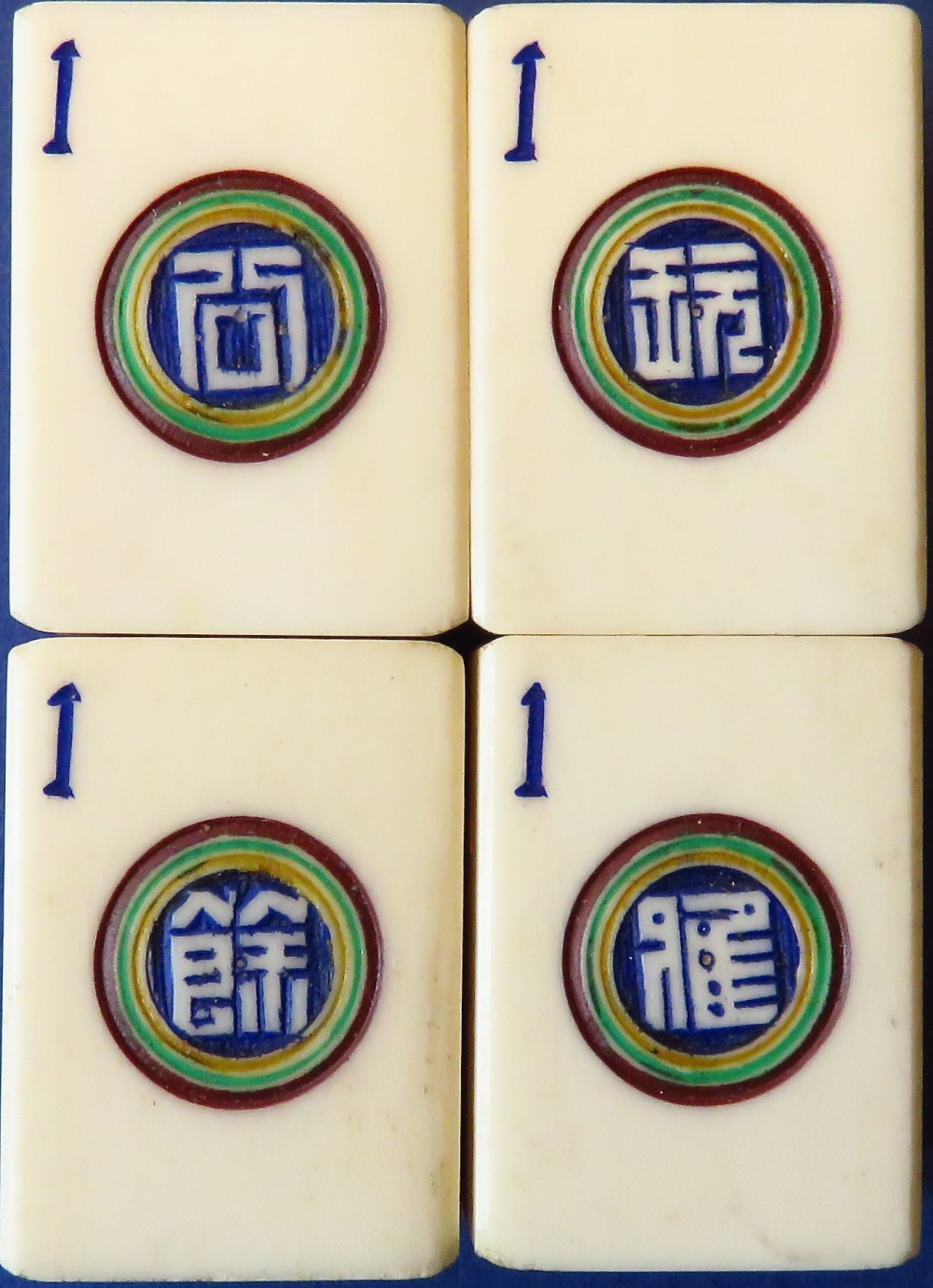
These number one circles have similarities with those in tile sets 34 and 35. They all have a green circular border with stylised sinograms in the centre. In this set they are simpler, in contrast to those in sets 34 and 35.
According to the 1st Edition of the Japanese Mahjong Museum book page 70, Photo 118, these are "Chinese luck letters meaning "play gracefully during leisure"".
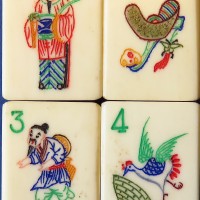
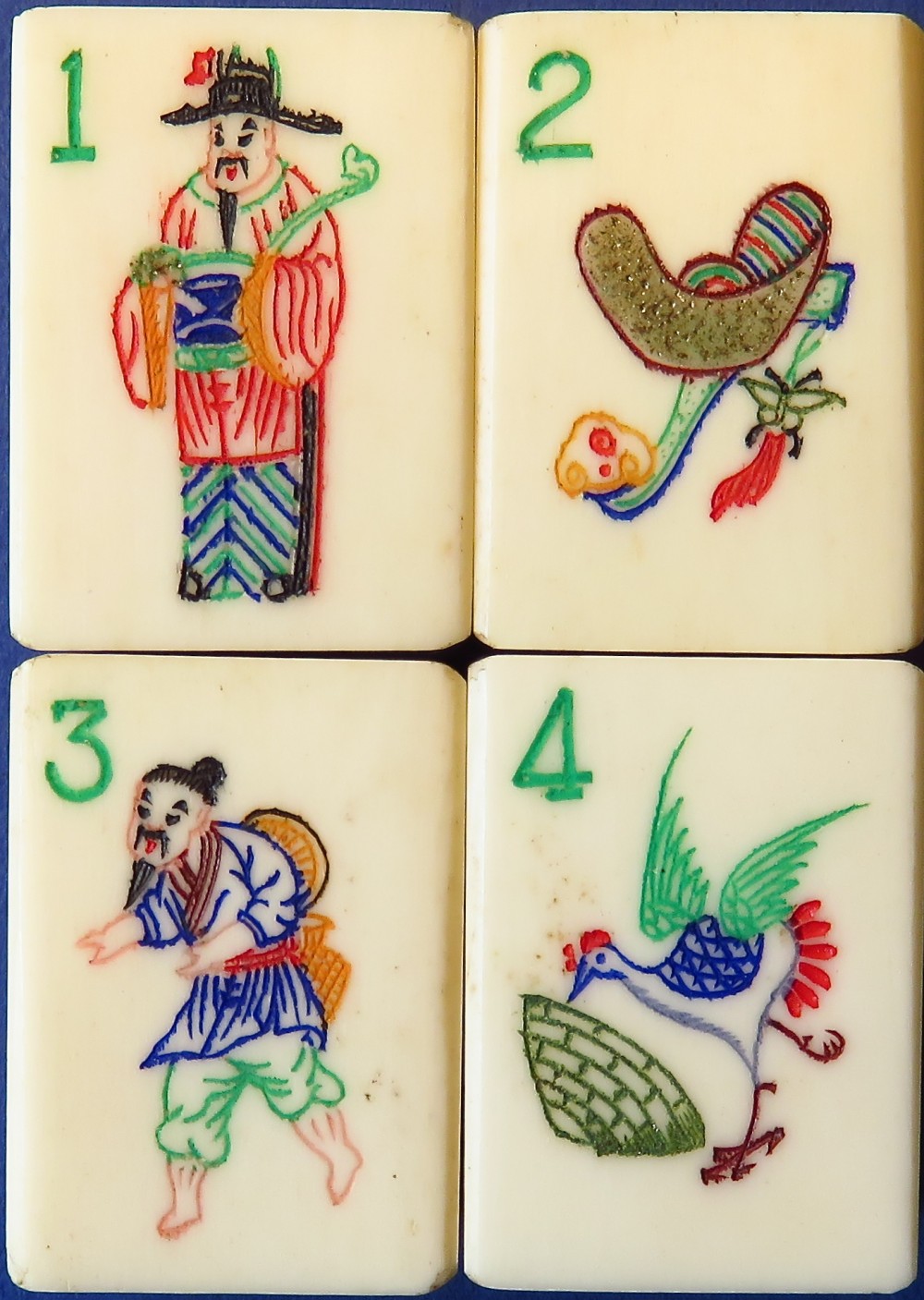
The Flowers (left) quartet show a simple proverb. As the Rich Man attains a gold ingot so does the lowly fisherman catch the bird who tried to eat a clam but whose beak was caught in the shell, thus allowing the man to catch them both.
The latter story is; One day a clam exposed on the riverbank opened its shell to take in the sun. A snipe came over to peck at the exposed flesh of the clam, which quickly closed its shell to clamp the bird's beak. "If no rain comes in the next few days, there will be a dead clam", said the Snipe. "If you don't get your beak free in the next few days, there will be a dead snipe", replied the clam. The along came a fisherman who easily caught them both. (see; San shi liu ji by Stefan H. Verstappen p 42.)
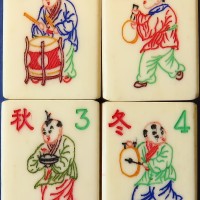
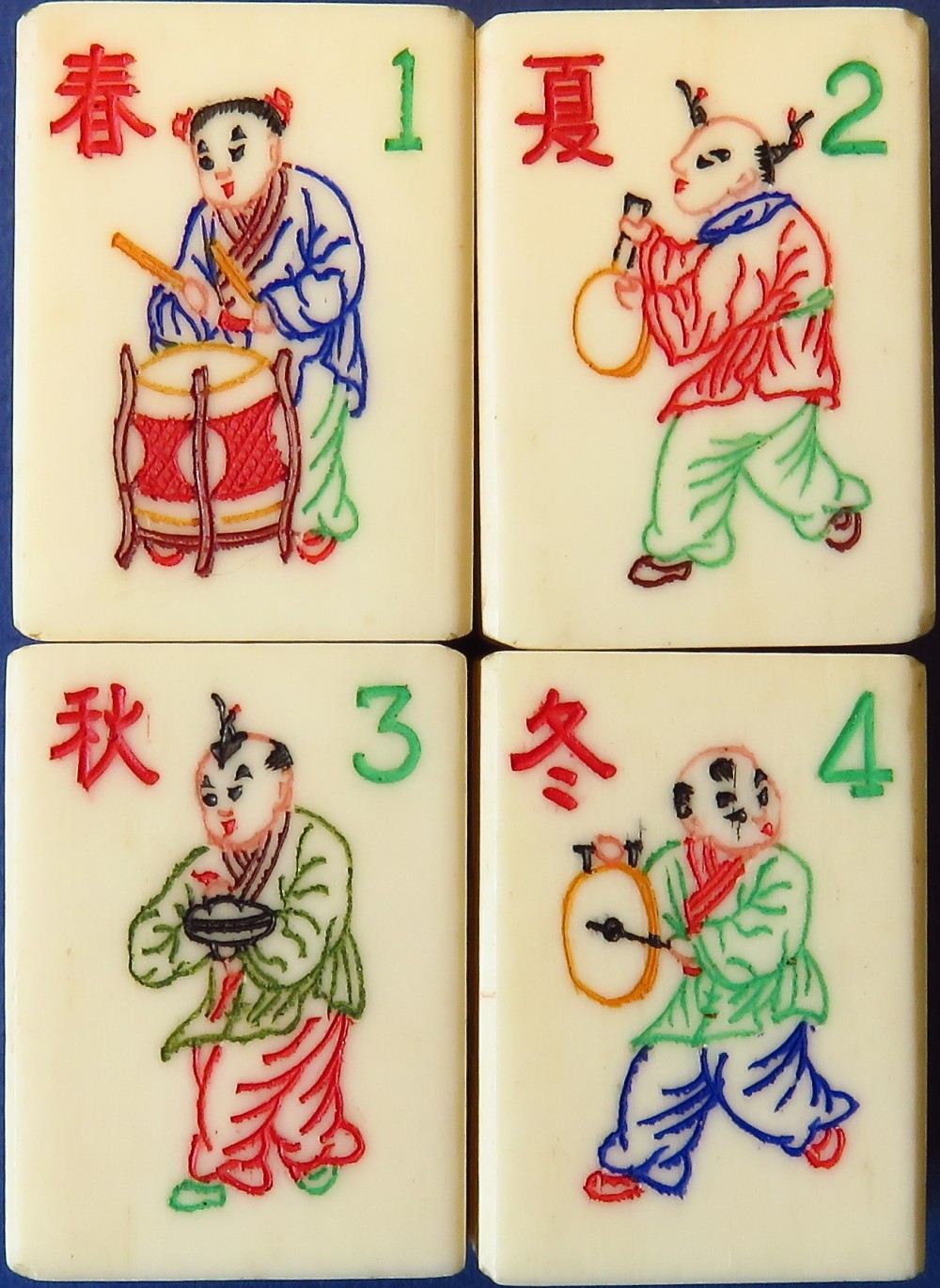
The Seasons (right) quartet have the sinograms for the four Seasons and are decorated with human figures.
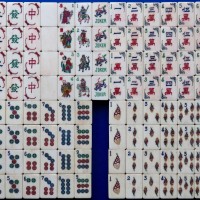
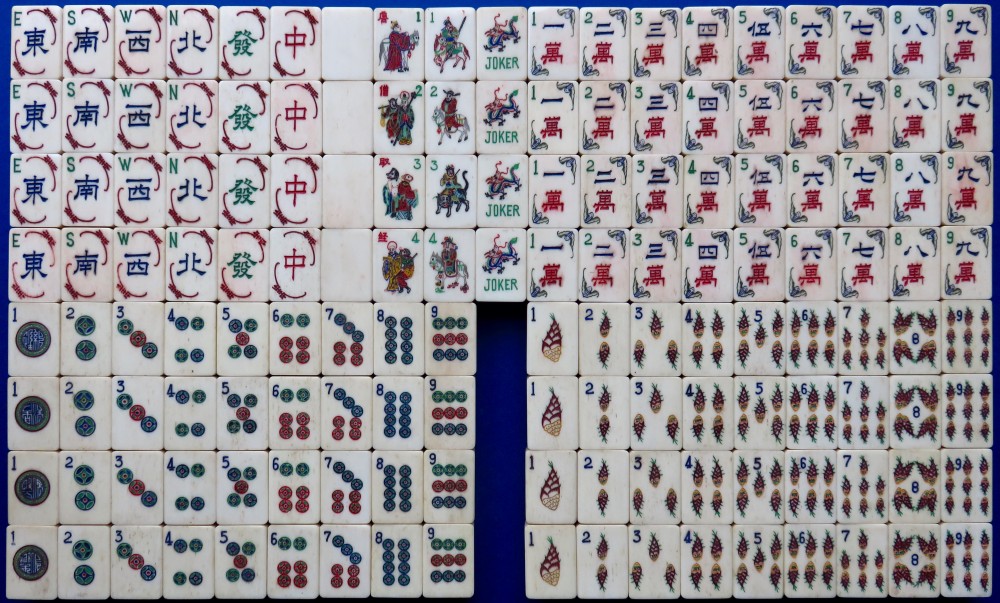
This is an example of a tile set that is fully decorated, presented in a flat, slide-top, rectangular box and probably from the same manufacturer as tile set 34.
The Directions tiles are decorated with pairs of whisker-like symbols for shou 'longevity' and the Myriads (of Cash)/'Character' suit has pairs of bats, the symbols for 'good fortune'. This motif is, unlike the preceding set, carried through to the red and green 'Dragons', perhaps a reference that these two groups of tiles were subsumed under one name, 'Winds'.
The SoC/'Bamboo' suit is decorated with bamboo shoots.
The four number one Cash or 'Circles' tiles are each decorated with a stylised sinogram while the rest of the suit is decorated with what may be colour patterns reflecting Chinese coins.
The two quartets of Flowers are decorated with human figures. (The sinograms have not been translated at this point).
The right quartet is similarly decorated with human figures.
The third quartet on the far right are Joker tiles sporting a Dragon on each tile.
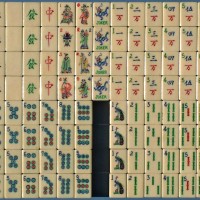
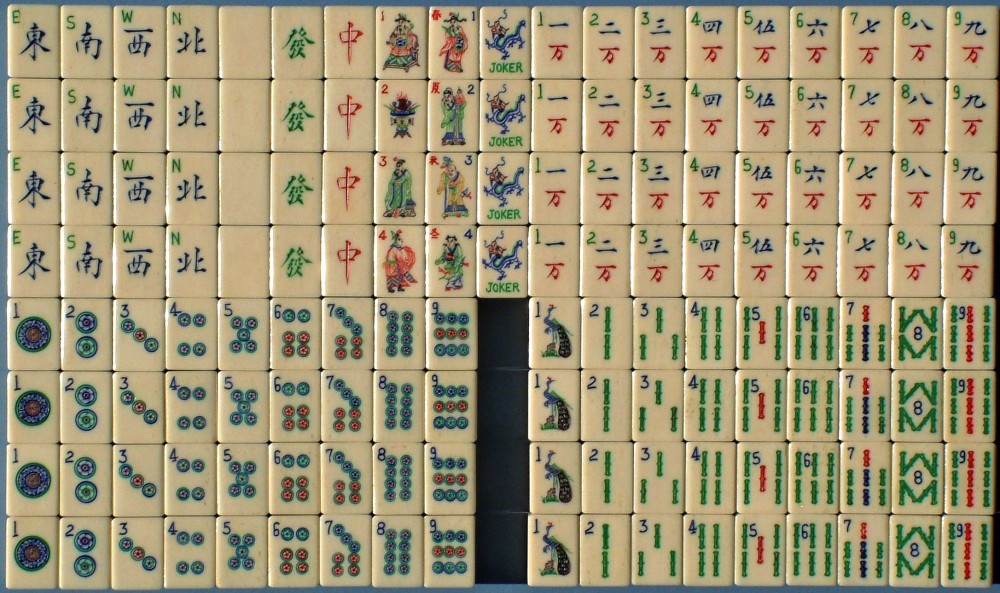
This set shows the features of the type exemplified by the preceding set. Note that there is a separate quartet of 'Joker' tiles.
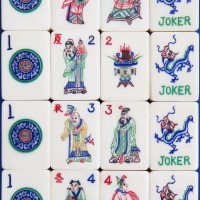
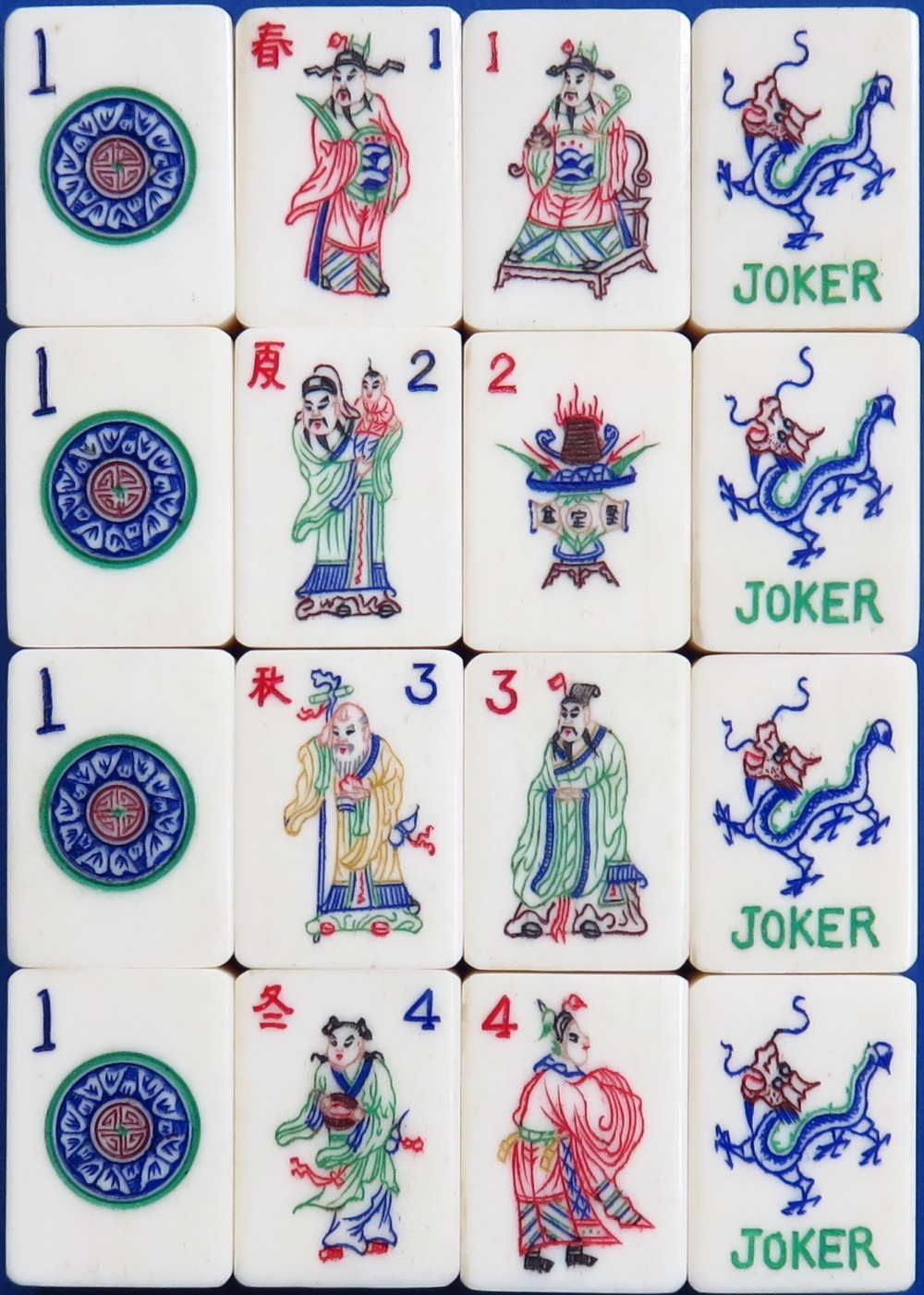
The Jokers are illustrated with Dragons. Again the Flowers and Seasons display human figures. The red sinograms on the right quartet read; Spring; Summer; Autumn and Winter.
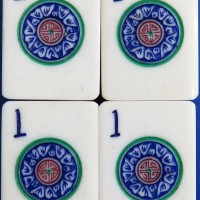
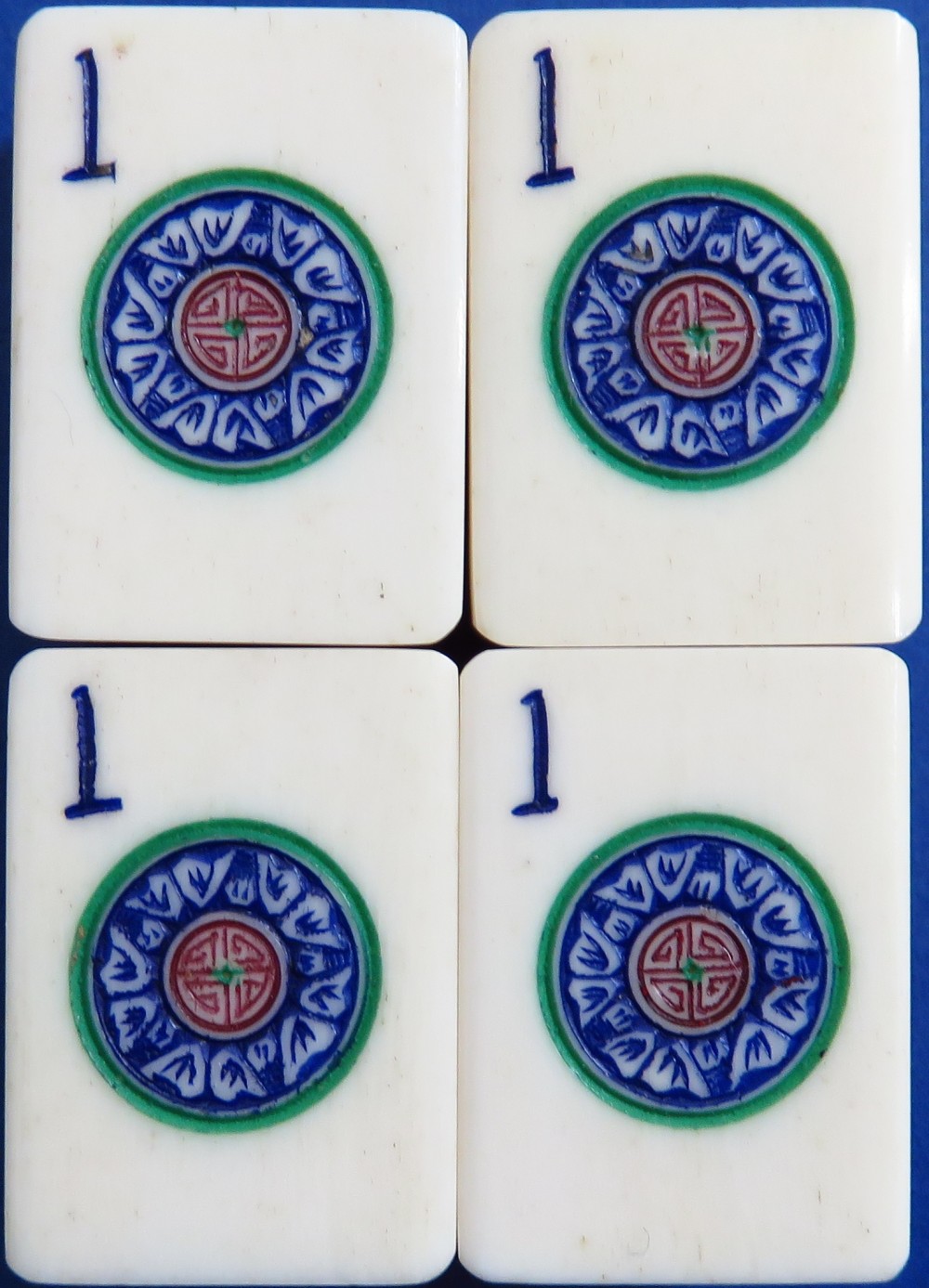
The motif on these four tiles is a common emblem in these types of set. It features five bats in blue, surrounding the red, central, circular Chinese character for "longevity" (shou 壽). The full expression that this motif represents is wu fu peng shou (五 福捧寿) or "five fortunes surround longevity".
The five bats represent the Five Blessings or Five Happinesses - long life, wealth, health, love of virtue, and a natural death only after achieving one's destiny.
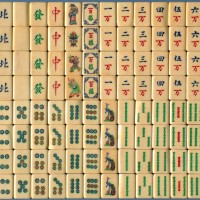
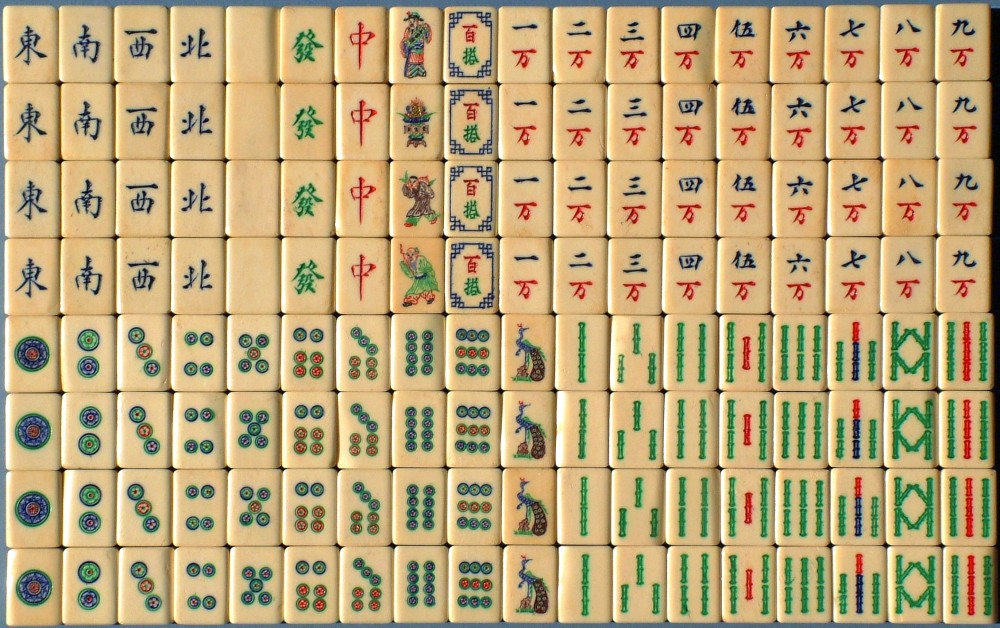
The tiles in this set are small and thick boned. Note the absence of English letters and Arabic numerals which may indicate it was destined for the non-Western market or the numerals were yet to be added on request of the purchaser.
Another feature are the number one Cash/'Circles'. They feature the circular symbol for longevity, shou, surrounded by five bats (see tile set 32 below for a fuller discussion).

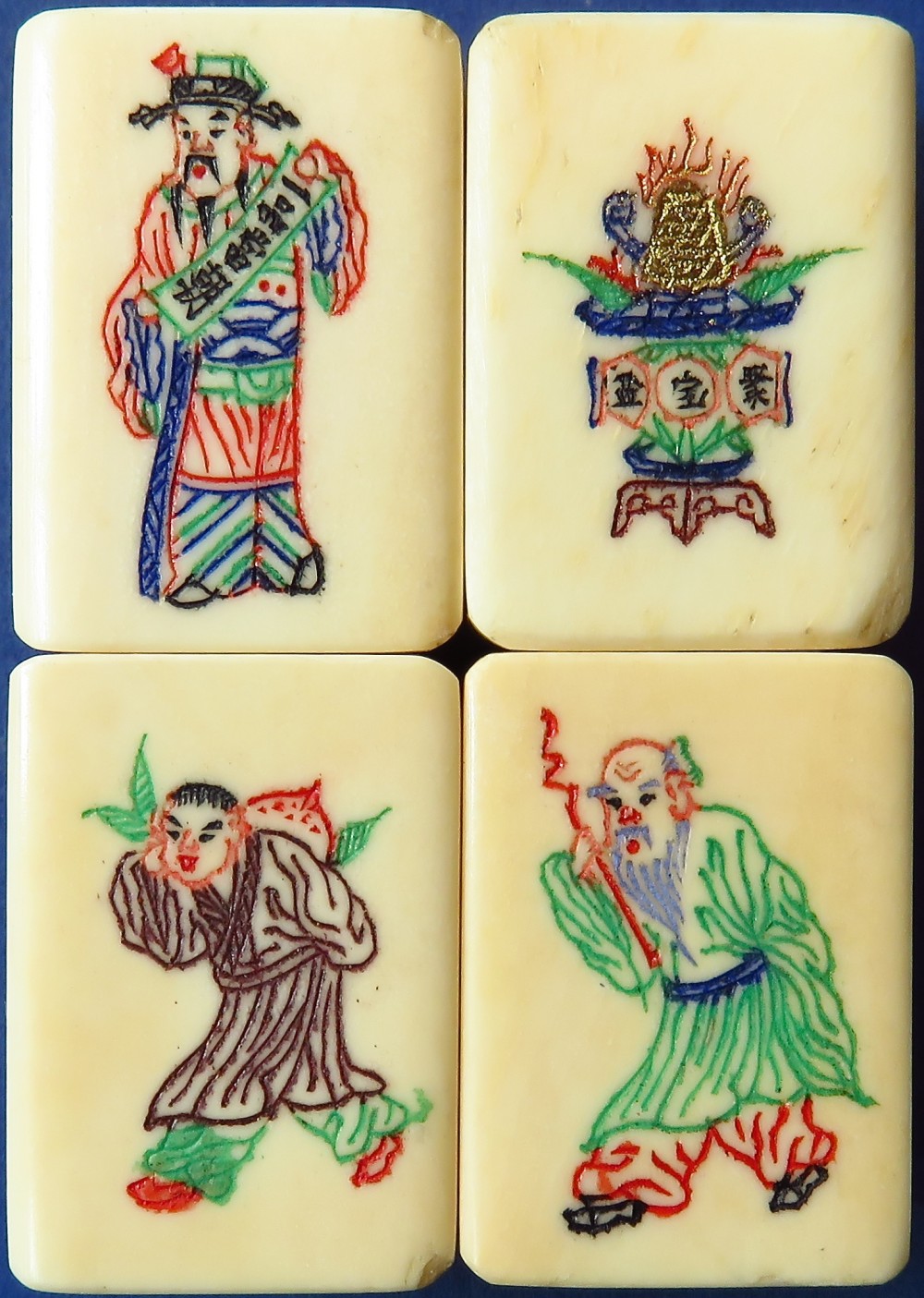
The left quartet of Flowers show human figures - the nobleman holds a scroll which reads; yi pin dang chau = one, quality, current, dynasty. Noblemen were granted titles by the Emperor and their rank was measured in pin, 'ranks' from one to nine. Yi pin/one pin was the highest rank among the 'pin' nobles. Hence the phrase means "The holder or owner has been granted the yi pin level of nobility by an Emperor of the current Dynasty". The sinograms on the 'pot-of-gold' read(R-L); ju bao pen = collect, treasure, pot (a common object in Chinese stories, similar to the Irish "Pot O' Gold"). So the nobleman may attain wealth when paired with the 'Pot of Treasure' and perhaps the young man has the wish for a long life (symbolised by the peach? on his back) and thus attains old age when paired with the old man in the subsequent tile.
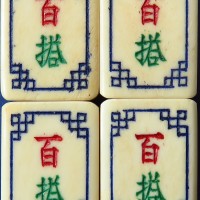
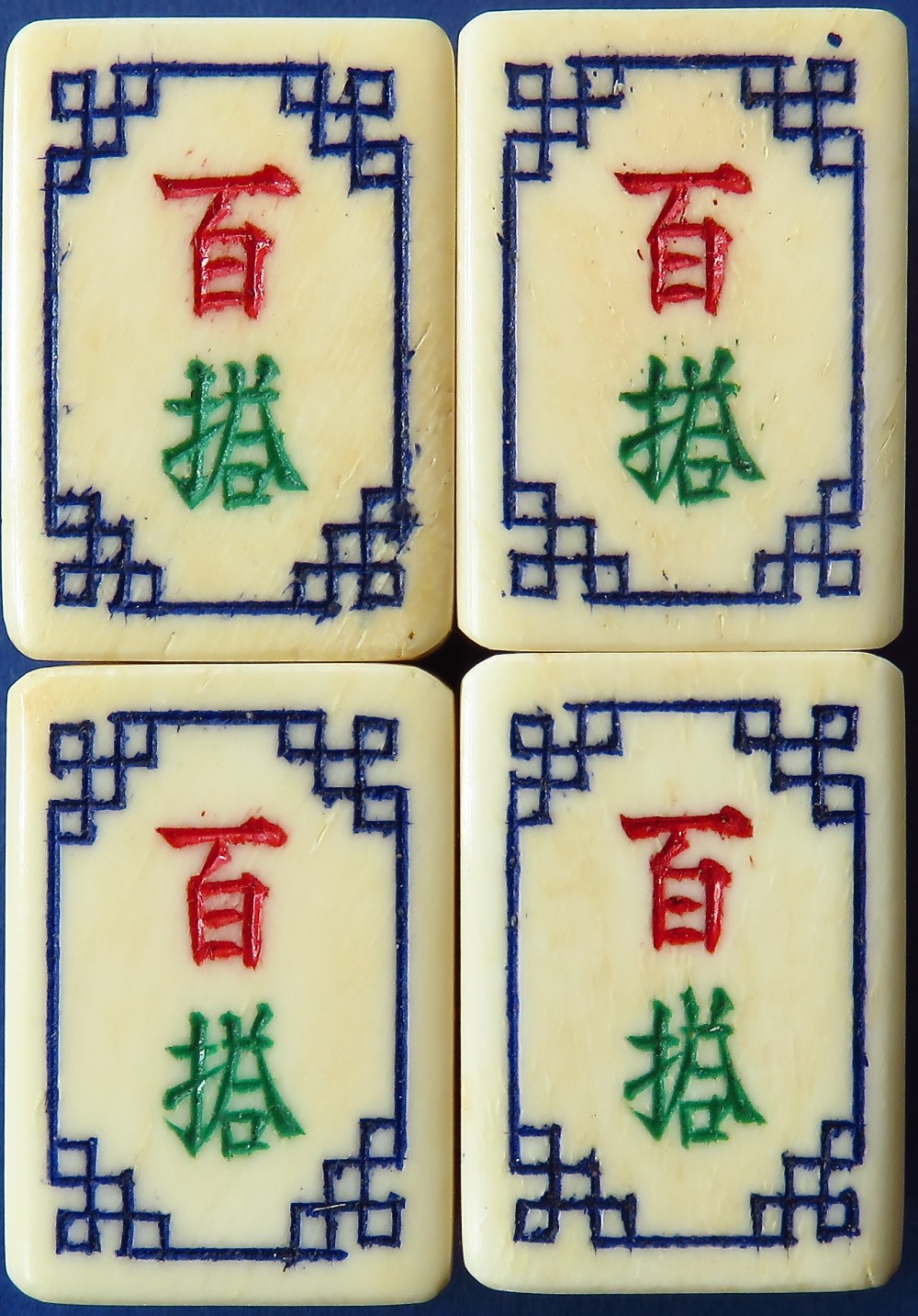
Close-up of the right quartet of tiles = bai da "one hundred joinings" = all purpose tiles or Joker tiles.
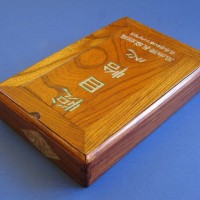
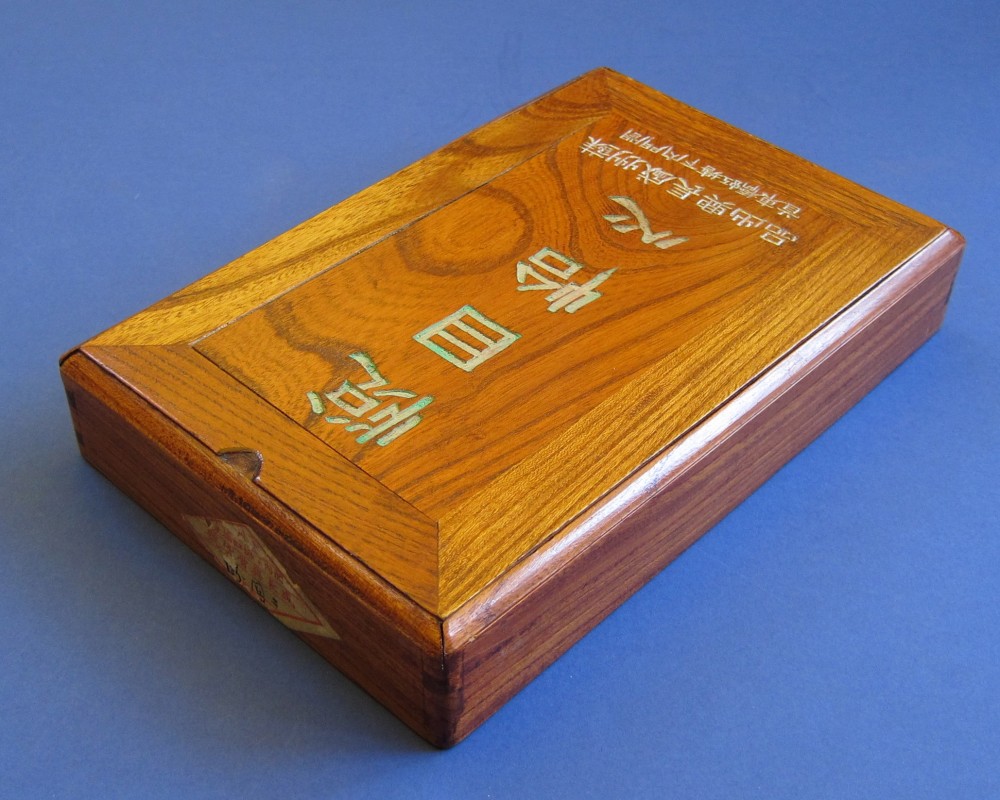
Decoratively grained, varnished, rectangular slide-top box with diamond-shaped manufacturer's label. Four, large, sinograms engraved into the wood and painted green with two rows of smaller sinograms underneath. The four large sinograms read; yue mu yi xin = "please(verb), eye, relax, heart". The size of the sinograms suggests this is a name or description of the game = "Relaxing to the eye and pleasing to the heart". The first horizontal row reads, right to left; su zhou sheng chang xing chu pin = Suzhou, vast/rich, long/many, joy/prosperity = "a long a prosperous future", and out, ware = product. So "Product of the Shengchangxing, Suzhou[Soochow]". The second line reads; chang men nei xia tang hung qiau dong shou = "Headquartered inside and beneath the Chang gate, East of the Tang arched Bridge. The box label reads; su zhou, chang nei xia tang hung qiau dong, sheng chang xing gu huo hao = "Suzhou. Inside and beneath the Chang gate, East of the Tang arched Bridge. Shengchangxing Tile-product (TM)".
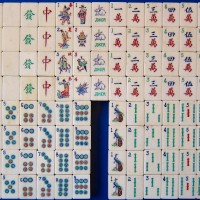
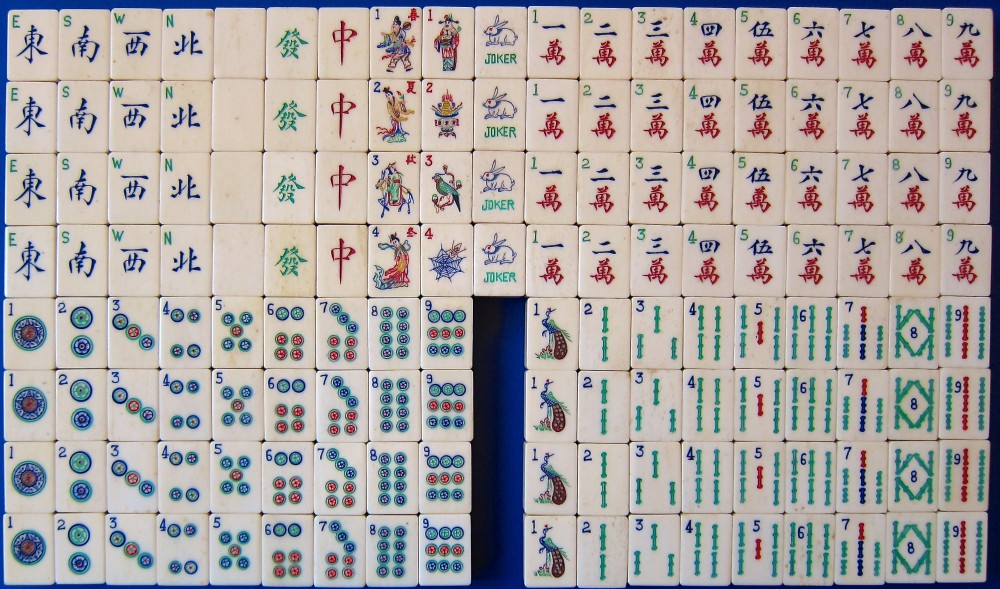
This tile set with small tiles is similar in make-up to tile set 32. It has identical number one Cash/'Circles' decorations (see tile set 32 for the meanings of this motif) and the rest of the suit is similarly decorated with flowers in the circles. The number one SoC/'Bamboo' is similar with its long tail as are the rest of the rods of that suit. However, the Myriads (of Cash)/'Character' suit has the traditional, more ornate form for wan.
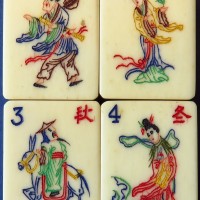
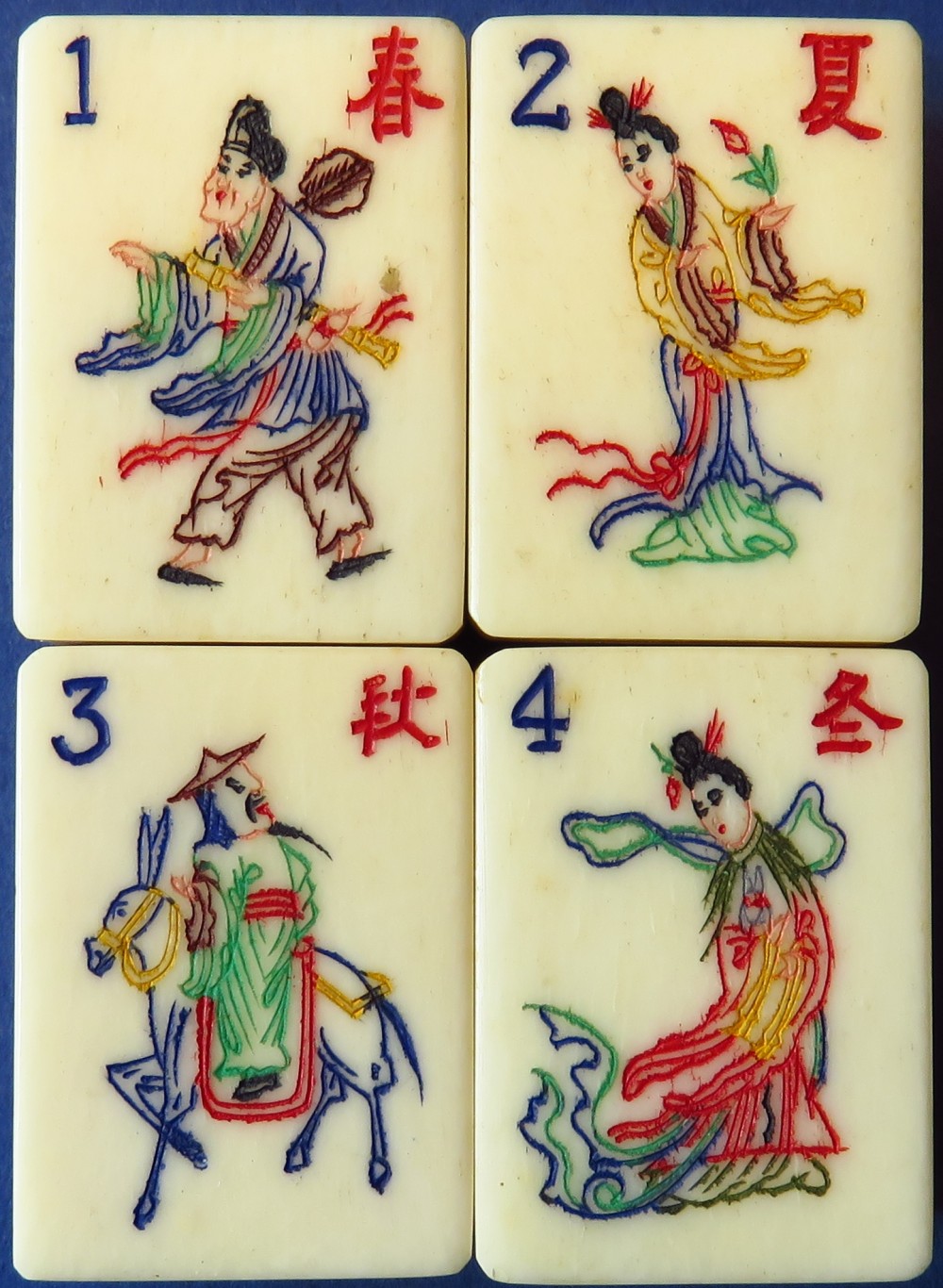
The Seasons quartet has the sinograms chun for 'Spring', xia 'Summer', qiu 'Autumn' and dong 'Winter'. The tiles are decorated with human figures.
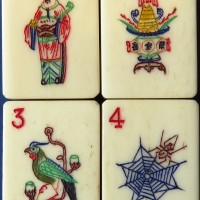
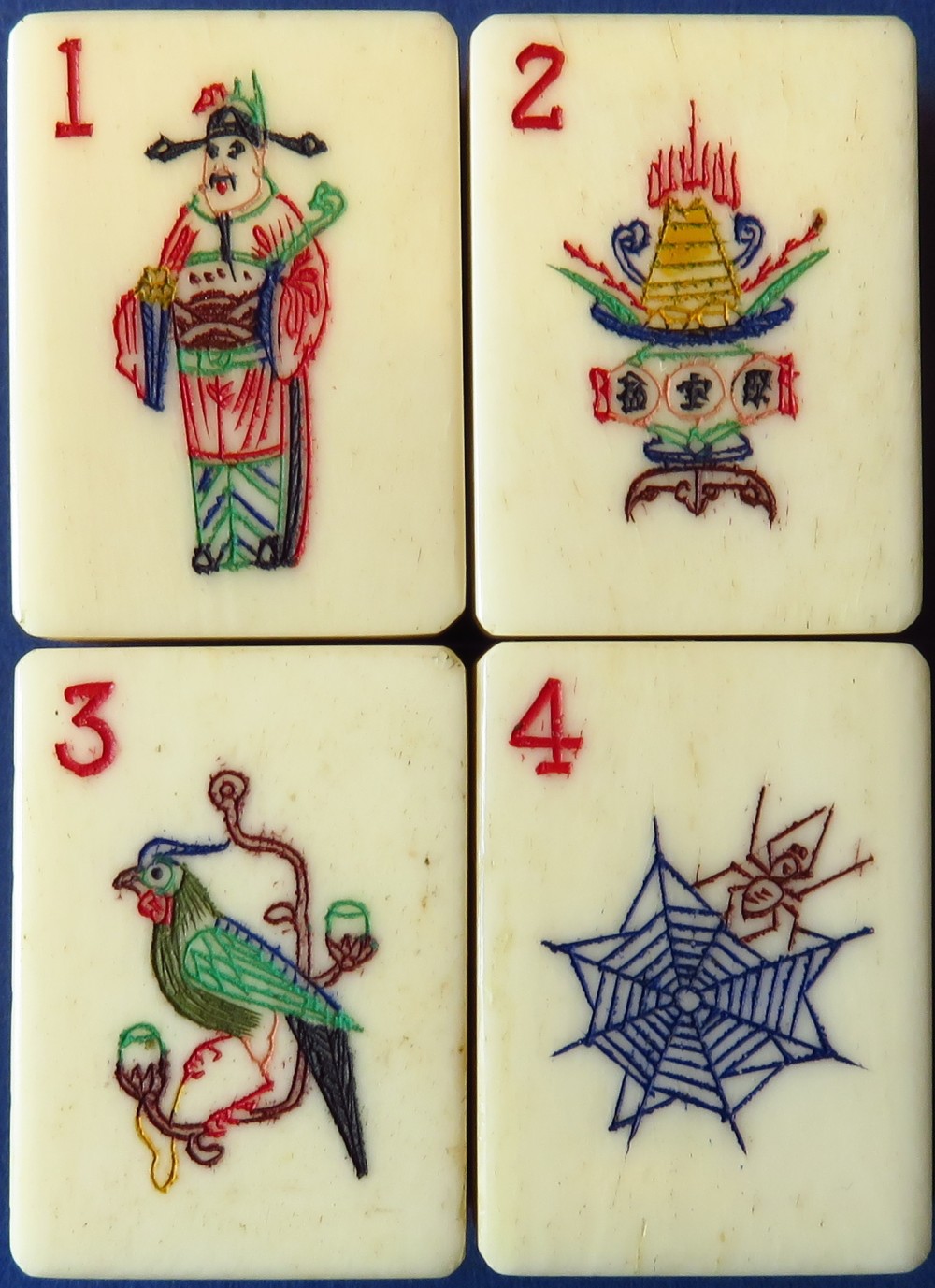
This quartet is decorated with a rich man/God of wealth, a crucible of gold, a bird and a spider on a web. Thus we have the rich man attaining/capturing wealth, the bird catching the spider - a similar pairing and function to the cat catching the rat.
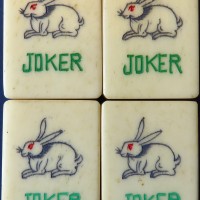
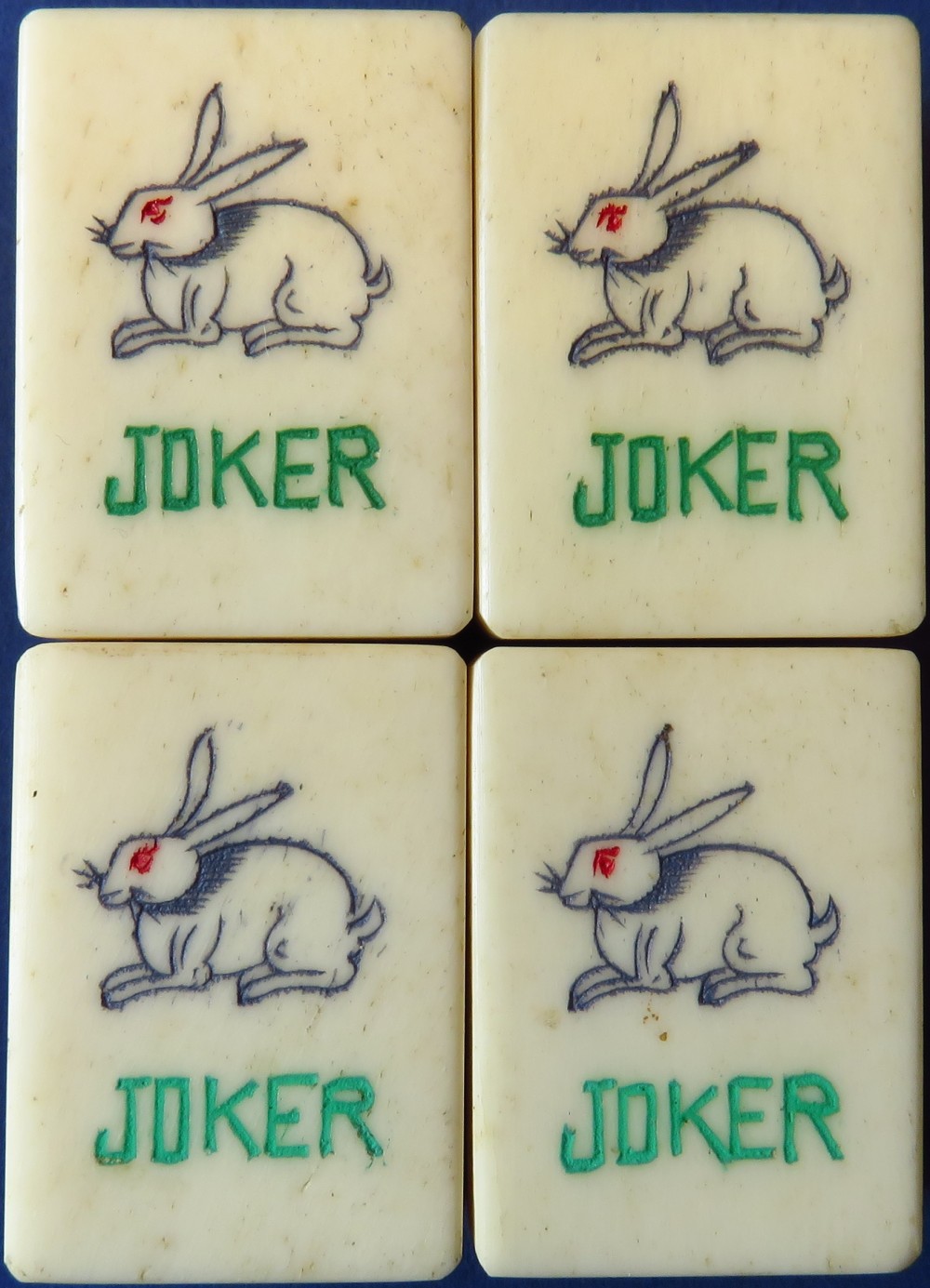
The four Jokers are decorated with rabbits - possibly a symbol of 'hope'. The three subsequent sets all sport this emblem on the Joker tiles.
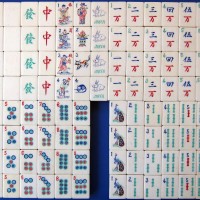
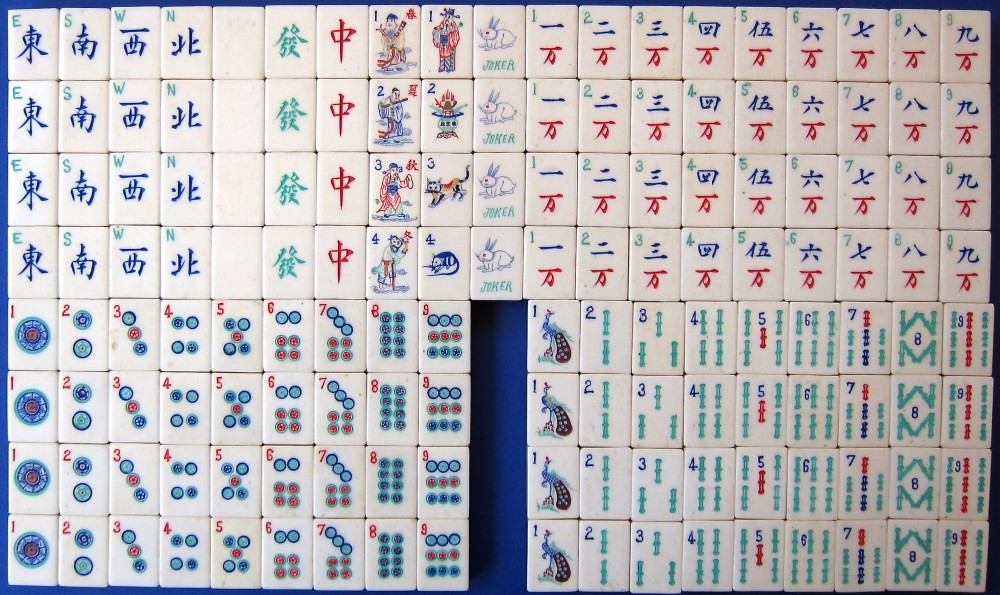
In this set note the mixing of ornate and simple engravings for the suits as in tile set 46.
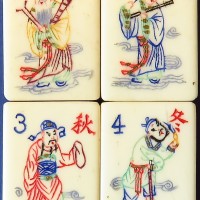

This quartet sinograms are chun, 'Spring'; xia, 'Summer'; qiu, 'Autumn'; dong, 'Winter'. The human figures are in fact four of the 'Eight Immortals'. From the top we have Zhang Guo-Lao, Han Xiang Zi, Cao Guojiu and Li Tieguai.
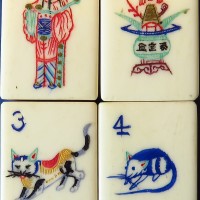
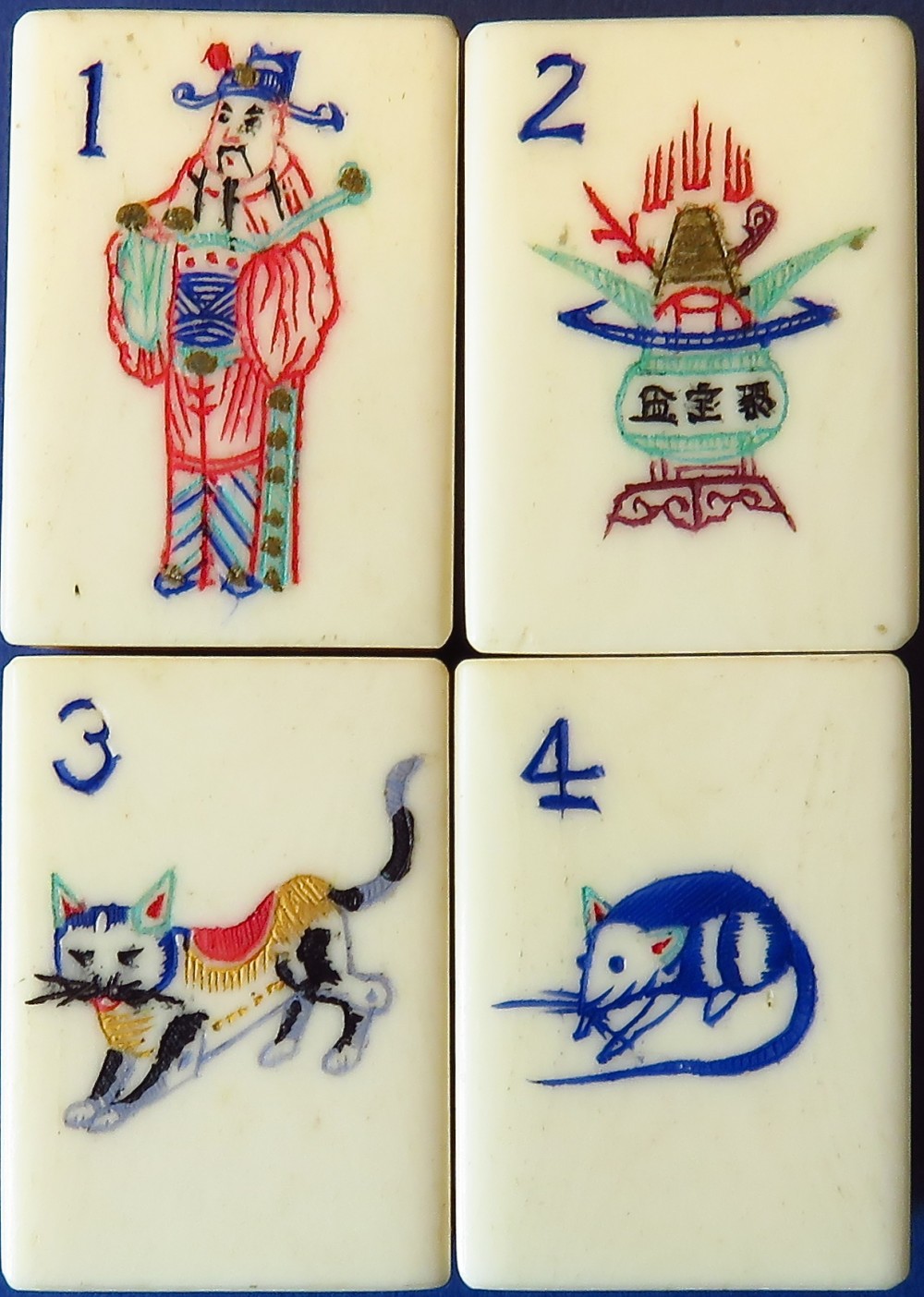
This quartet are show the pairings of Rich Man/God of Wealth, a crucible of treasure or wealth, a cat and a rat. Thus the Rich Man seeks to attain wealth, and the Cat catches the Rat.
These are similar pairings and functions to the tiles in set 36(see 36c).
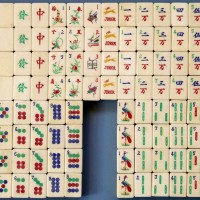
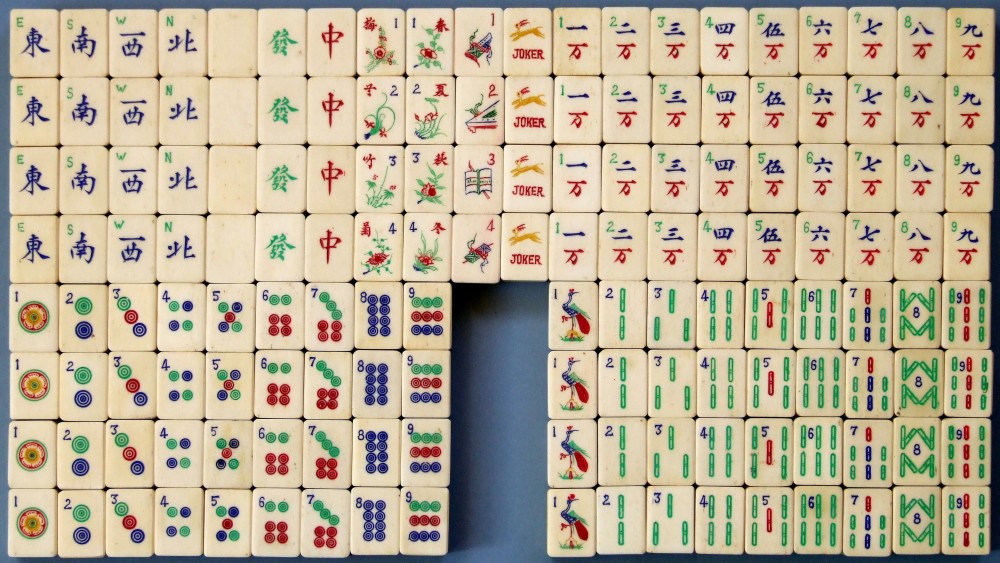
Small tiles. This set features the use of yellow - an uncommon colour in MJ sets. Note also the simple rods in the SoC/'Bamboo' suit', simole circles for the Cash/'Circles' suit and the simplified form of wan for the myriads (of Cash)/'Character' suit. The left quartet of Flowers/Seasons sinograms' reads; li 'plum'; lan 'orchid'; zhu 'bamboo' and ju 'chrysanthemum' and are decorated with their respective flowers. Together these form the four noble plants. The left quartet read; chun 'Spring'; xia 'Summer'; qiu 'Autumn' and dong 'Winter'. The plants are the peony, the lotus bloom plus bud and leaf, the pomegranate fruit and the narcissus. Together these spell out a blessing which, if you have viewed other sets in this section, you will know as "may you have riches (peony), concord (lotus) as a married couple (narcissus) with many sons/children (pomegranate)". The Jokers quartet are decorated with yellow rabbits ('hope').
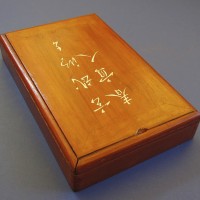
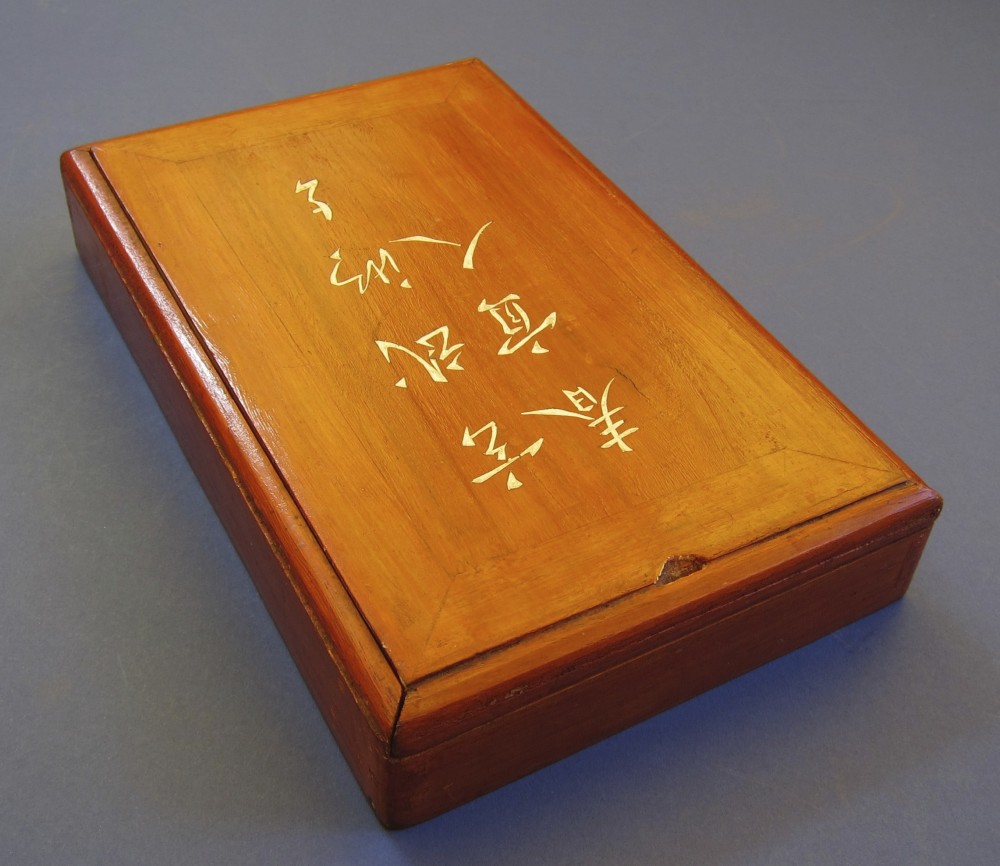
Read -stained, flat, rectangular box with a slide-top lid with seven engraved sinograms painted in silver.
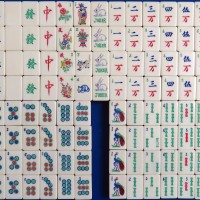
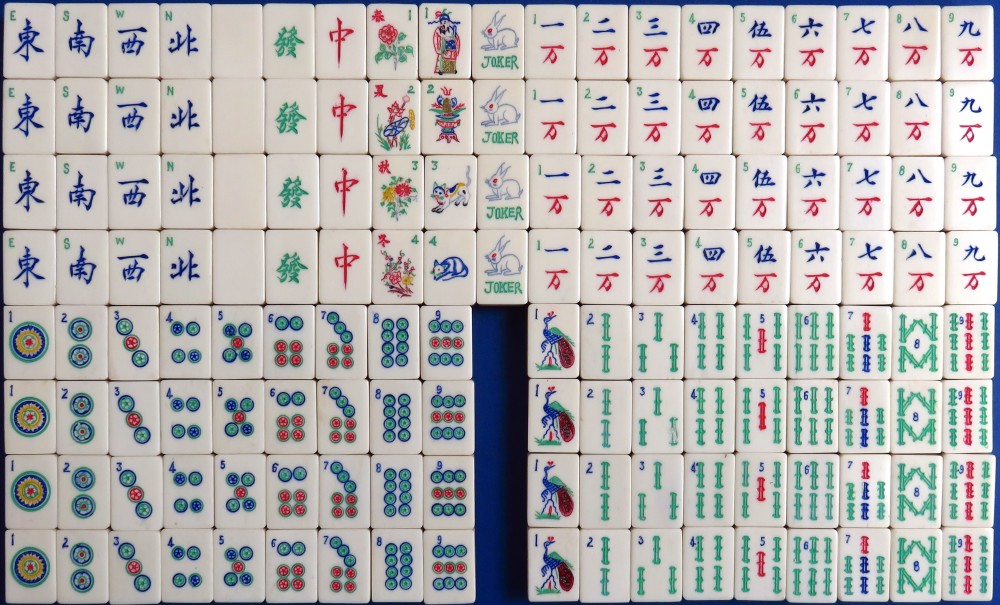
This tile set features the common motif of a rabbit as the Joker emblem. The same tile set pattern is there as in previous sets - including the bird standing on one leg with head turned to the right.
Note the ornate style of the 'Circles' and 'Bamboos' suits in contrast to the simplified form of the 'wan' character in the 'Characters' suit.
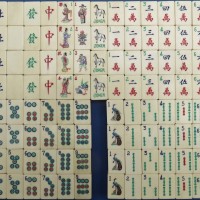
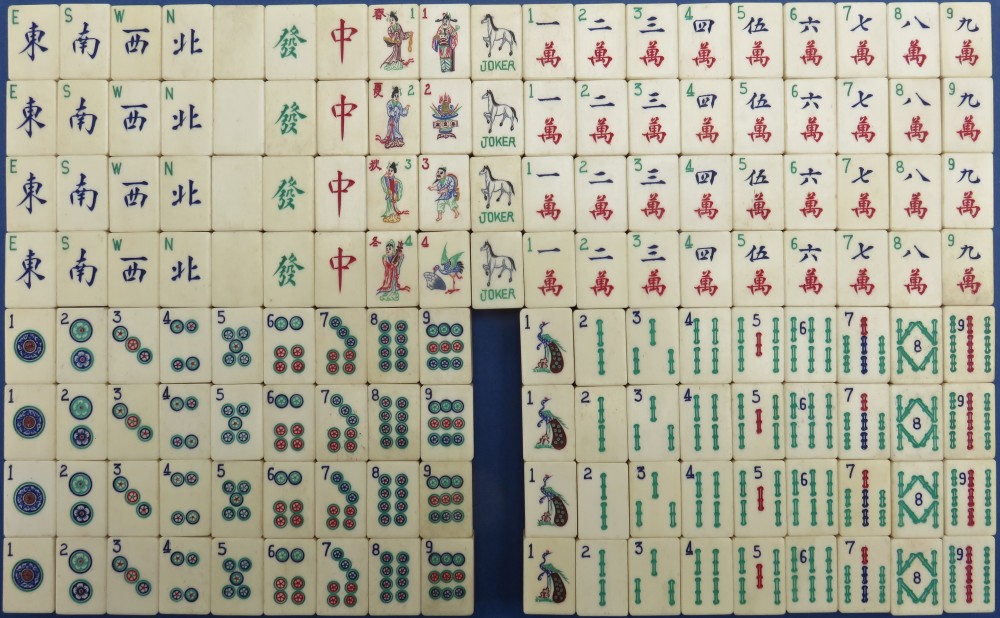
As in previous sets, this one has horses as emblems for the 'Joker' tiles. It also has the four 'capture' tiles with the Fisherman and the snipe with its beak trapped in a clam.
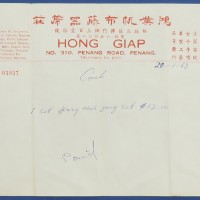
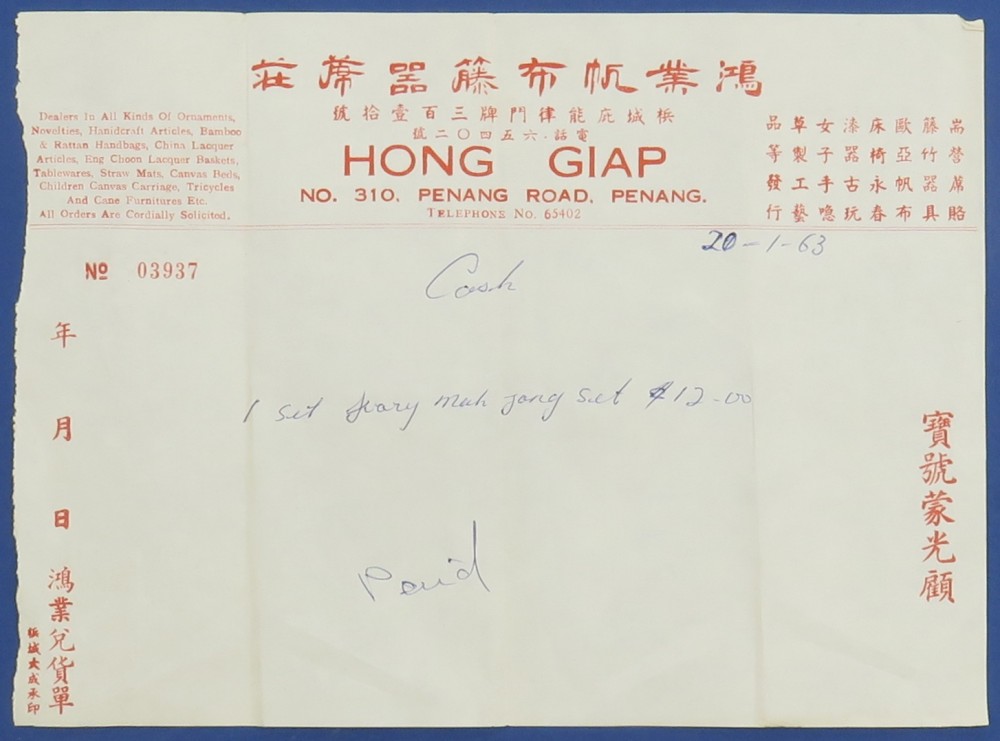
Receipt original to the set, showing place of purchase - both the shop and the locations, purchase price and importantly, the date.
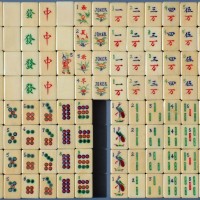
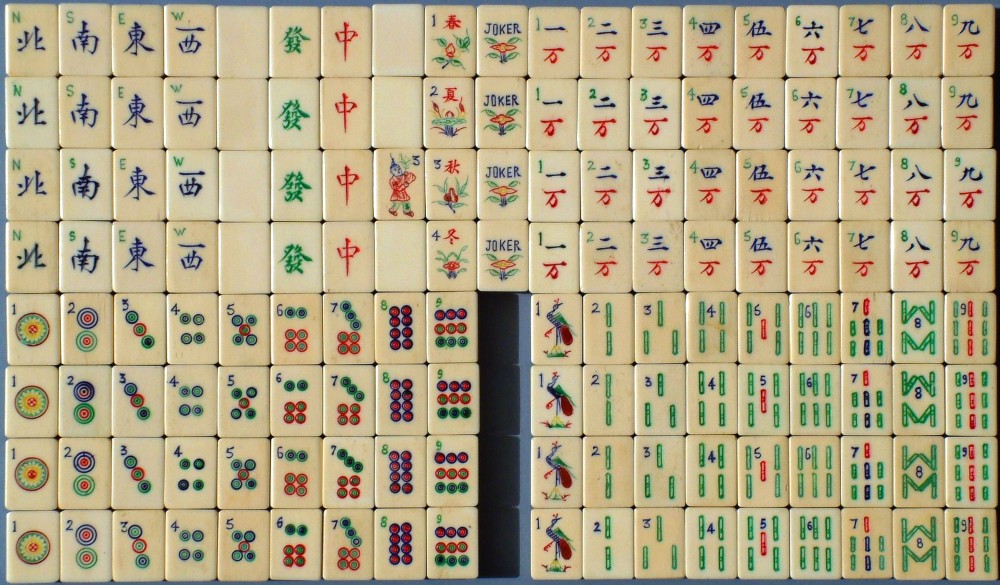
This tile set was bought in 1963 but may have been languishing in the shop storeroom for some time due to the dust covering it had. It is now missing three tiles. The left quartet of Flowers/Seasons were Fisherman, Woodcutter, Farmer and Scholar. The right quartet are the usual, Spring, Summer, Autumn and Winter. The plants are the Peony, Lotus etc., Pomegranate and Narcissus = "may you have riches, concord and a happy marriage with many children".
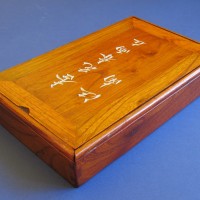
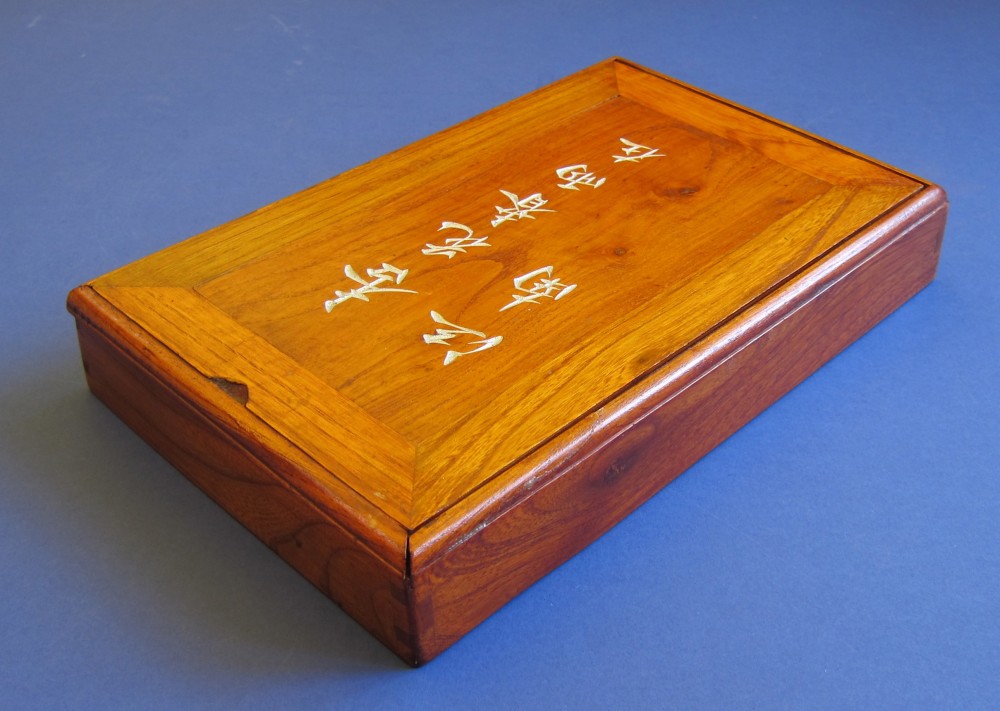
Stained, rectangular, slide-top box. There are seven engraved sinograms on the lid, written in what appears to be a cursive style script, painted in silver. From the top right column; xing 'apricot', hua 'blossom', chin 'Spring', yu 'rain', zai 'at', Jiang 'Yangzi(river), nan 'South'. Jiangnan = area south of Yangzi river. Therefore we have "apricot blossoms and Spring rain at Jiangnan".
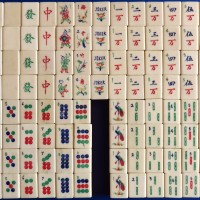
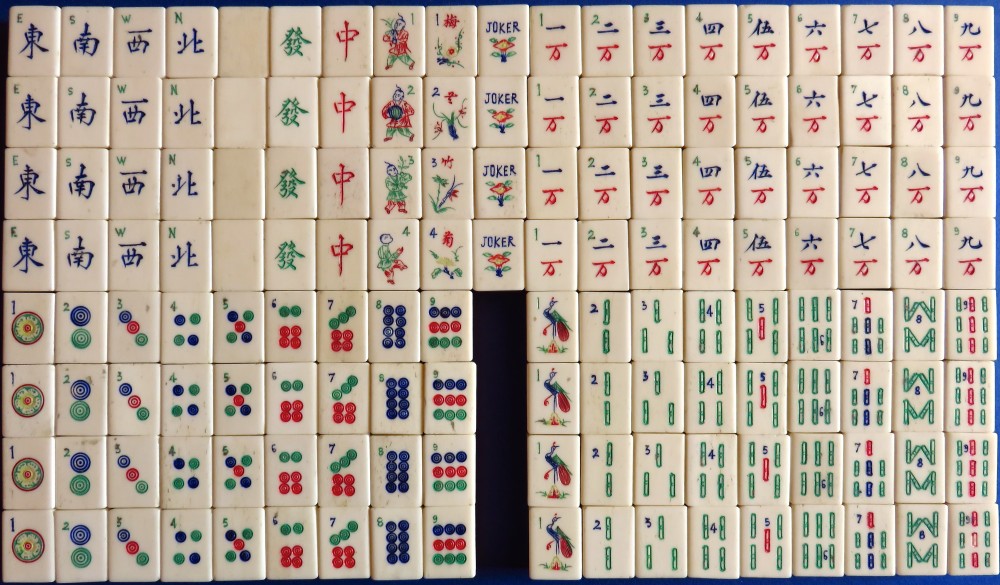
This set is very similar to the preceding set. The designs on the tiles, their colouring and size suggest this set probably came from the same manufacturer.
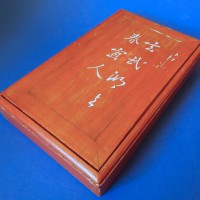
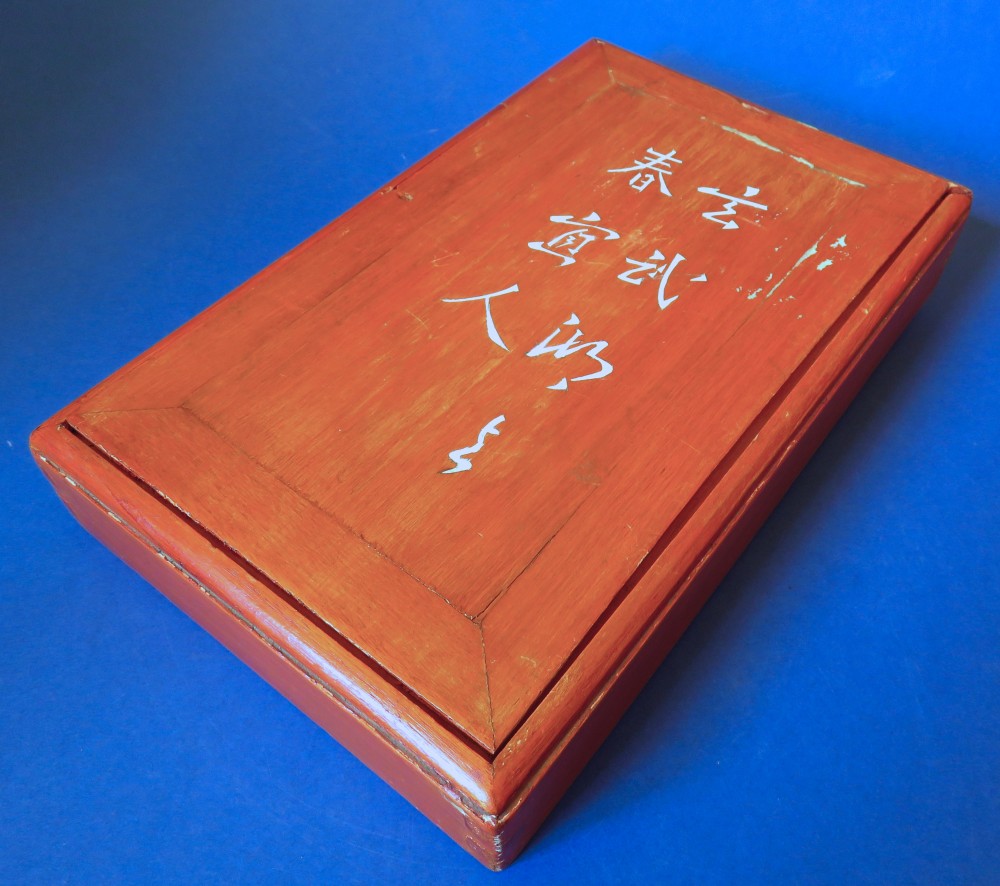
Stained, rectangular, slide-top box. There are seven engraved sinograms on the lid, written in what appears to be a cursive style script, painted in silver. Again, similar colouring and script to the preceding box.
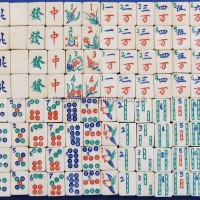
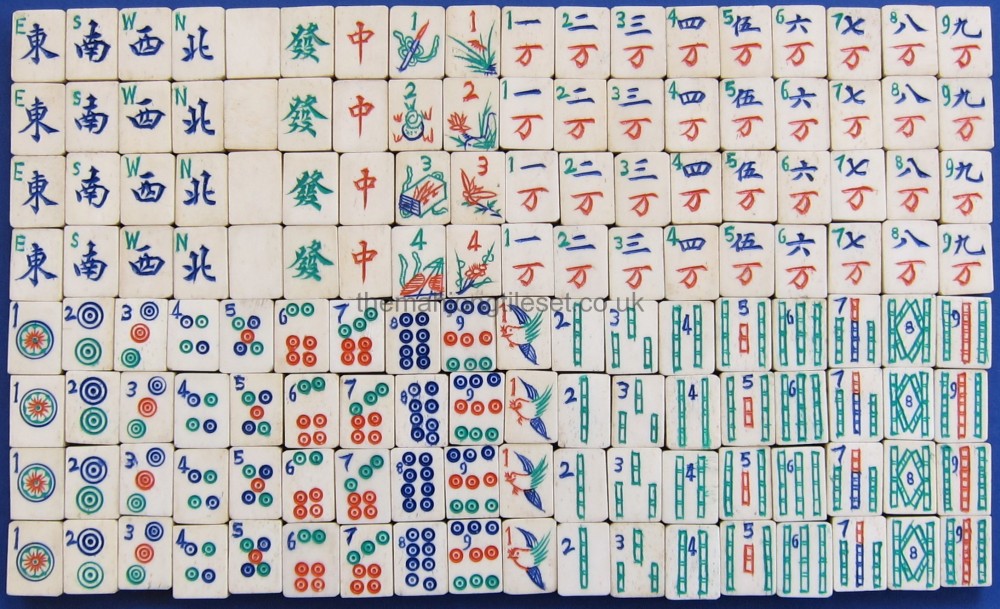
Very small tiles with single circles on the Cash/'Circles' suit. The Flowers sport various symbols of writing, ingot?, book and the world. The Seasons may be represented by plants. From the top down chrysanthemum (Autumn), lotus (Summer), peony (Spring) and plum (Winter).
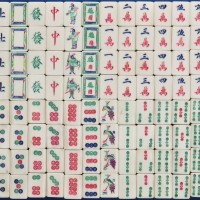
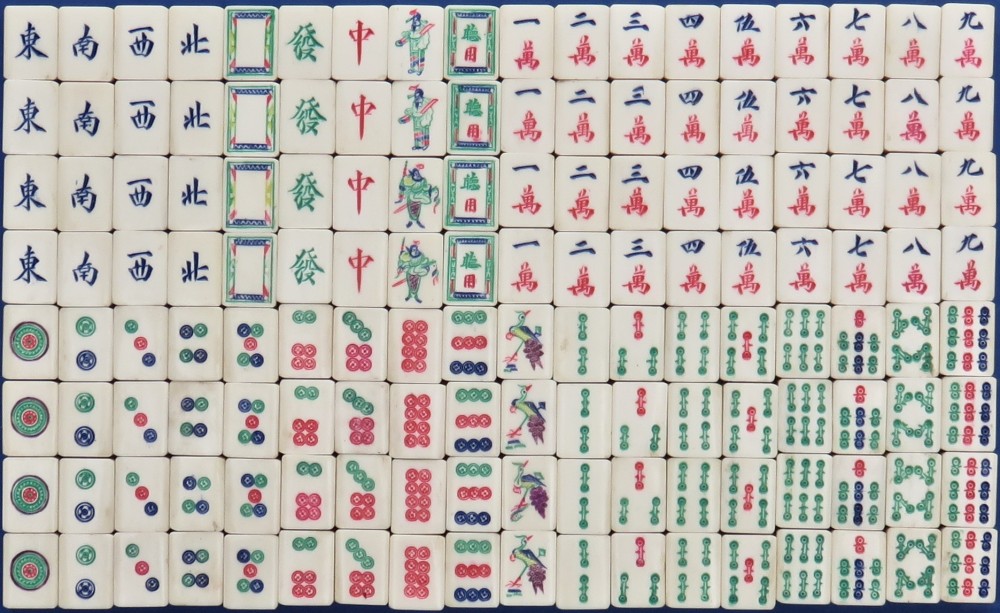
This is an uncommon and unusual variation of the Culin Pattern. Note the use of the unusual round motifs for the 'Bamboo' suit, the unusual way the human figures are engraved as well as the unusual bird and the colouring on some of the tiles.